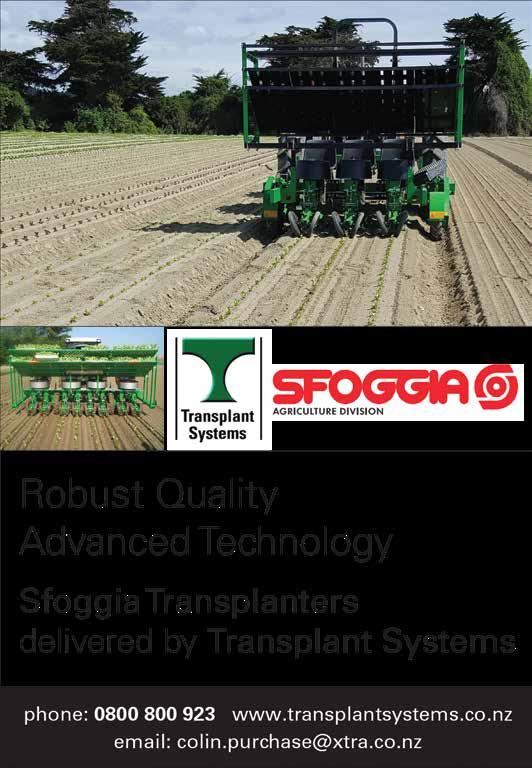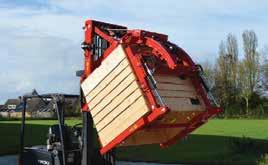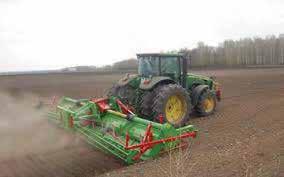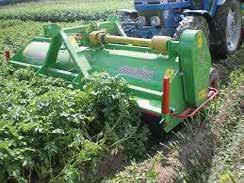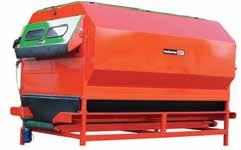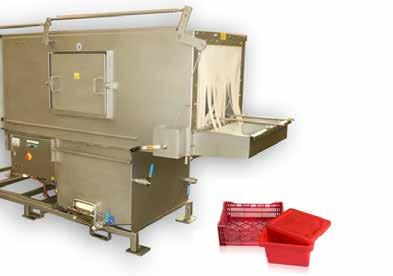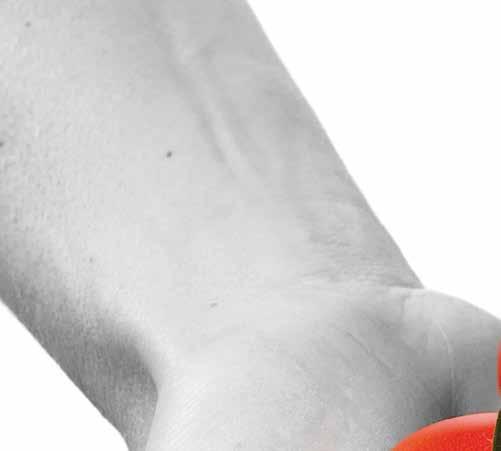WHAT�S THE PRICE OF RISK?



Growers across New Zealand can reduce the climate impact of the covered cropping industry and prepare for a shifting operating environment and customer preferences.





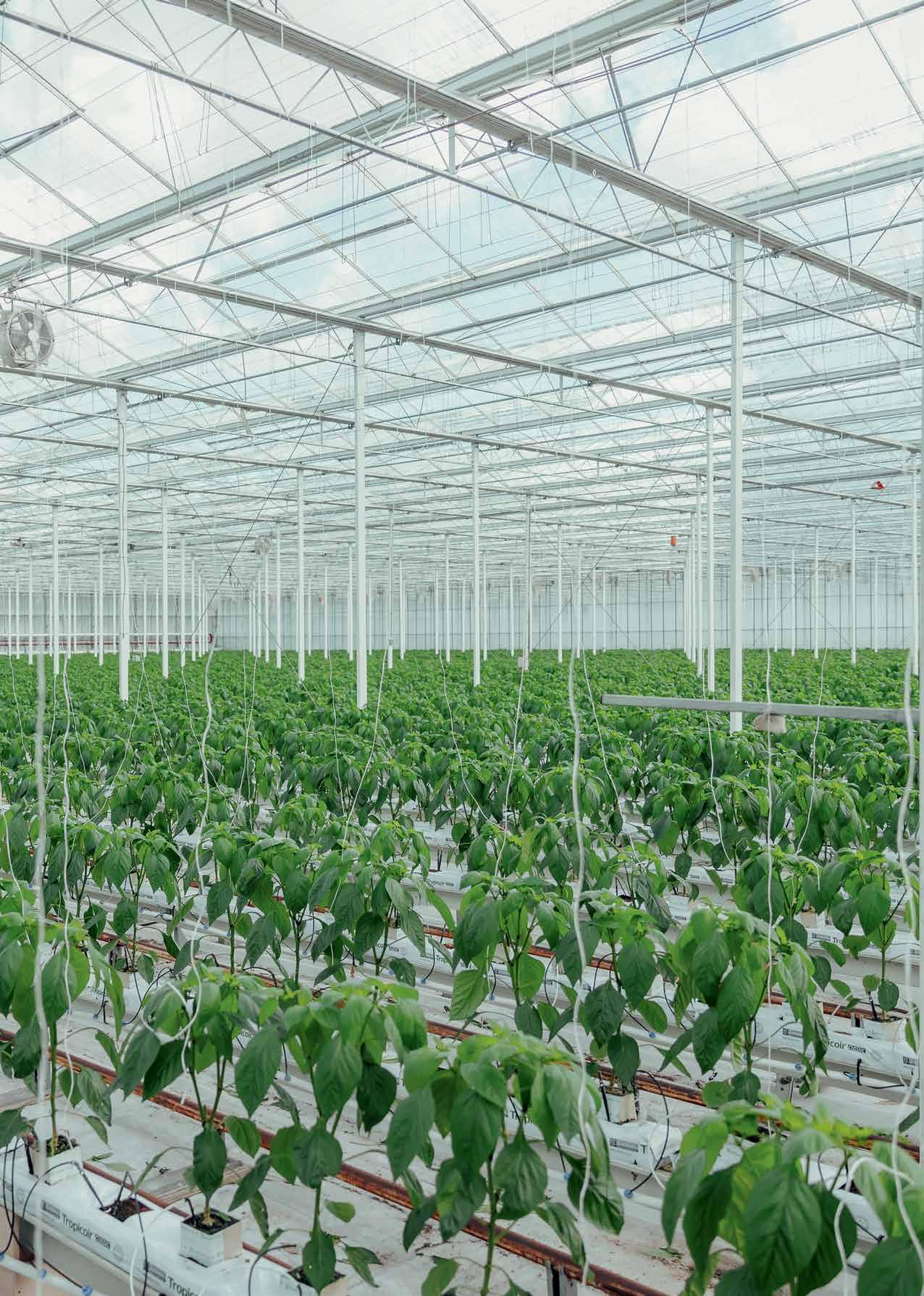
The Covered Cropping Decarbonisation Pathway will help growers work together to reduce their emissions.
The 5 step pathway will give growers access to:
• International expertise











• Best practice guidance
• Bespoke tools and resources.
Discover more at eeca.govt.nz/coveredcropping

2 President’s Word: International collaboration is needed in today’s world
4 The Chief Executive: Growers under the pump

6 Growing Change – a freshwater solution for horticulture
8 Rationing fruit and vegetables in New Zealand?
10 Tools of the biosecurity trade
13 Berryfruit scientist won’t stop ‘growing something’
16 Support on the ground for Northland rural communities
20 ’Blue highway’ an option for growers
24 Prices need to reflect level of risk
26 Testing crop protection with native groundcovers
30 Experimenting with less fertile soils
TECHNICAL
37 La Niña ends – what’s next?
40 Crop residues, fallow periods and management practice
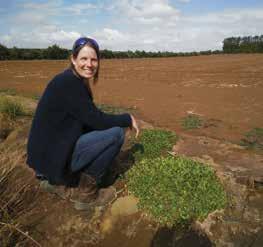
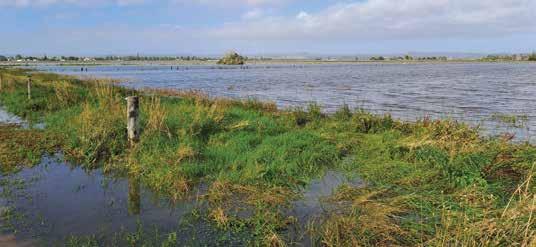
PRODUCT GROUPS
45 Vegetables NZ Inc.
48 Onions NZ Inc.
52 TomatoesNZ Inc.
54 Potatoes NZ Inc.
Robin Oakley and daughter, April, the sixth generation to work in the familyʼs Canterbury business. On page 24, Robin shares his thoughts on vegetable prices and managing risk.
A regular advertorial section of new products and services. This publication does not endorse the products or services featured here.
56 Advanced Hort – Call for Ellepot field trialists
57 Fruitfed Supplies – R&D brings new solutions to growers

58 Wearparts – Growers find efficiencies with trusted after-market parts
59 Heat and Control – Size reduction technology for fresh produce
Recently I said we need to find ways to collaborate better within New Zealand, but hadn’t thought too much about this in a global sense. I have observed however, that while we might at times say the right things about collaborating internationally, the reality has been more that we cherrypick what we collaborate on in the belief that we will benefit more directly by not being fully transparent, and that greater collaboration would be detrimental to our own opportunities and aspirations.
The 10th World Avocado Congress had the largest number of global attendees for a New Zealand horticultural event ever, with more than 750 people coming from 33 countries, and in total 1160 attendees. A big shout out and congratulations to Jen Scoular and team NZ Avocado for firstly winning the rights to host the congress, and then secondly making this awesome event happen. Fantastic achievement!
I was really impressed by the willingness of the international speakers to openly share both the challenges and opportunities for their sector globally. The science being undertaken, including the collective investment involved, was very impressive, with excellent presentations on many significant
areas for New Zealand growers. This includes the breeding of new varieties along with more drought and disease tolerant rootstocks, production methods and planting systems to increase productivity (including trellising), and ways of improving storage to extend fruit shelf life for transport and marketing.
New Zealand with 4000 hectares of avocado production is tiny compared to the world total of 490,000 producing hectares, and while our growers and NZ Avocado do a great job within their means, it would be naïve to believe we as a country can afford or achieve all that is required for future success. Just the research needed, for example, to increase orchard production by addressing biennial bearing is huge. For many of our avocado orchards producing only 5 tonnes per hectare, it would mean raising this closer to the few producing 20 tonnes per hectare.
Avocados are big business worldwide, currently estimated at over US$9 billion in fruit value and likely to be $20 billion in 2027. Internationally 2.5 million tonnes were traded in 2020–21, making up 3.6 percent of the global fresh fruit trade and eighth on the list – bananas of course being number one. Of all fruit categories there is a staggering 70 million tonnes of fruit traded each year internationally, valued at US$85 billion.
And avocados are even more impressive when it comes to the value of trade, US$6.6 billion or eight percent of global fruit trade, and fourth on the list, behind only bananas, grapes and apples.

Mexico is the biggest exporter by far, at 1.5 million tonnes, and these large volumes have had impacts on other producing countries, especially in California where the production area has halved over the last decade due to in part to increased input costs, especially for water, but also market prices staying static due to the volumes of imported product.
And increased production is forecast to see an excess of supply of possibly up to 30 percent by 2026, from a balanced supply situation in 2021. Amazing growth, so there are absolutely going to be challenges, but opportunities are very much still present, especially when 50 percent of world exports are to the United States, and another 30 percent to the European Union and United Kingdom, which leaves the rest of the world consuming only 20 percent of the global production.
If producing countries focus collaborative efforts and resources on getting the 20 percent of the world, seven billion people, to increase their consumption just a little, the market is huge. But if we continue to operate in isolation, due to the scale of the challenge there is unlikely to be significant movement.
Avocados like most fruit and veggies are great nutritionally, which is a major lever to use in our promotion efforts. And when only 10 percent of consumers in the United States are meeting daily fruit and vegetable consumption requirements for a healthy diet, even the US market still has huge potential.
Last month I had the pleasure of attending the World Avocado Congress in Auckland, and it made me think on the need for global collaboration.Barry O’Neil : HortNZ president
NZ GROWERS PRODUCE
2 PERCENT OF GLOBAL AVOCADO SUPPLY
NEW ZEALAND US $150M (APPROX)
WORLDWIDE US $9B AVOCADOS ARE BIG BUSINESS IN GLOBAL FRESH FRUIT TRADE –AND HIGH VALUE 3.6 PERCENT OF PRODUCTION, BUT 8 PERCENT OF VALUE
Unfortunately, trends worldwide have seen global obesity increase significantly, with over 40 percent of adults being classified as overweight. People don’t want to be or like being overweight, and countries don’t want their people overweight especially due to the health costs. Enabling and supporting people to eat healthy fresh fruit and vegetables is the number one way to address this problem.
Sadly, the statistics also indicate more than three billion people in the world can’t afford a healthy diet, due to it being two to five times more expensive than an energy and nutrient sufficient diet – or putting that another way, junk food is far too cheap compared to good food!
That doesn’t make sense or seem right, and while we are working on getting our government and its policy makers in New Zealand to address this, we also need to see change around the world. By working together with what we have previously seen as our competitors, we will have the best chance of promoting to consumers this great healthy product, and will achieve the scale needed giving us all a far better chance to influence consumers purchasing decisions.
NEW ZEALAND AVOCADO PRODUCTION IS SMALL ON A GLOBAL SCALE BUT WE ARE THE WORLD’S NINTH LARGEST AVOCADO EXPORTER
My conclusion is that we all can and will benefit when we share information with our domestic and international counterparts, about how we can achieve better outcomes for the wider fruit and vegetable sectors, including research and alignment of efforts to address customer and consumer needs. In a global world, and even as competing countries, we need to avoid doing things that cause division, that create a ‘them and us’, as that will only cause confusion and damage to the category.
The world nowadays is so connected and information on nearly everything is freely available, that if we are not fully transparent and collaborating openly with others, it might be interpreted as having something to hide…
Yes, there are head winds ahead for avocados, as with other sectors in horticulture in New Zealand, but we do have the opportunity to work collaboratively not only within New Zealand, but also with other producing countries to make a difference. Individually as companies and countries we are too small when it comes to achieving critical mass and scale internationally for the changes and outcomes that are needed.
Kia kaha.Editor:
Andrew Bristol
Ph: 021 021 62 021
Email: andrew.bristol@hortnz.co.nz
Advertising Manager:
Debbie Pascoe
Ph: 027 485 8562
Email: debbie.pascoe@hortnz.co.nz
Design: Scenario Communications
Ph: 04 385 9766
Email: joy@scenario.co.nz
Subscriptions:
Email: info@hortnz.co.nz
NZGrower is produced by Horticulture New Zealand and is free for all levy payers. The magazine is also supported by: Vegetables New Zealand Inc, Process Vegetables NZ, TomatoesNZ, Potatoes New Zealand Inc, Onions New Zealand Inc.
The individual comments and views in this magazine do not necessarily represent the view of Horticulture New Zealand.
ISSN: 2230-2700 (Print)
ISSN: 2744-5712 (Online)
This publication uses vegetable based inks and environmentally responsible paper produced from Forest Stewardship Council® (FSC®) certified, Mixed Source pulp from Responsible Sources.
Paper produced using Elemental Chlorine Free (ECF) and manufactured under the strict ISO14001 Environmental Management System.
The wrapper we use is 100% recyclable, it is LDPE 4 (Low Density Polyethylene) Soft Plastic and meets the required standards. For further information refer to: https://www.recycling.kiwi. nz/our-story

The pictures of silt-covered orchards may no longer dominate the 6 o’clock News, but for those affected – the growers, their employees and their whānau – the aftereffects of Cyclone Gabrielle still hit hard. To add insult to injury, the government increased the minimum wage on 1 April, and scheduled a ten percent increase on top of that for the Recognised Seasonal Employer (RSE) scheme –effective 1 October.
Many growers still do not know the timeframe for getting their land back into production or the next crop to market. Northland, Bay of Plenty, Tairāwhiti and Hawke’s Bay are the fruit bowl and vegetable basket of New Zealand for good reason. Their soil is, or at least was, rich with the necessary nutrients to support the nearly $7 billion New Zealand horticulture industry.
However, silt has not only destroyed the plants that were growing on that land when the cyclone struck, it has suffocated the soil structures, which means many crops may never be able to be grown on this land again. Experts predict it will take 50 to 100 years to get the soil back to what it was.
All this has come at a time when growers are already under immense pressure. RSE workers, who have come here every season for the past 15 years from our Pacific neighbours, fill shortfalls in domestic employment and help keep our successful horticulture industry alive.
SILT HAS DESTROYED GROWING CROPS AND SUFFOCATED THE SOIL STRUCTURES. MANY CROPS MAY NEVER BE ABLE TO BE GROWN ON THIS LAND AGAIN
EXPERTS
IT WILL TAKE 50 TO 100 YEARS TO GET THE SOIL BACK TO WHAT IT WAS
Growers affected by Cyclone Gabrielle are grateful for the government’s financial support, but one-off grants or loans only offer temporary relief.
Approximately one-third of our horticulture yield is sold domestically. The rest is exported. Internationally, we are price takers, meaning we can only get the price the world market sets. Domestically, where they can, growers will need to factor into their prices the increased cost of production. This will put further inflationary pressure on households when they can least afford it.
I have spoken with growers who are contemplating their future in a post-Gabrielle world. The latest round of wage cost increases is likely to mean they either do not rebuild and replant, or if they do, it will be on a reduced scale.
This is not about wanting to pay RSE workers less. They are an important part of the ecosystem, not only in our domestic economy but for the Pacific Islands, where the money they earn in New Zealand provides an important lifeline.
The horticulture industry is not asking for special favours. We are just asking for the opportunity to get ourselves back on the trajectory we were on before the myriad of extreme weather events.
The RSE scheme is not perfect – no scheme is. There are a few bad actors, which is why the horticulture and viticulture industries are working closely with the government and the Pacific on a review to address the issues.


The forced increase in RSE wages will hurt the good actors – by far the majority – the most. These are the growers who have already invested significantly in their RSE workforce. They travel to the Pacific Island communities from where their workers come, to nurture long lasting and trusted relationships. They build practical and culturally appropriate accommodation for the workers when they are in New Zealand. It is their slimmer margins that cannot sustain an inflexible wage environment.
It is always challenging when the government forces employers to pay workers from overseas more than they would pay New Zealanders for the same work.
The cyclone-affected horticulture industry is facing increased costs across almost every aspect of growing. Insurance helps, but it doesn’t cover everything. It doesn’t provide for increased supply chain costs because it is now harder to get produce to market. It doesn’t accommodate additional employee flexibility because they need to be able to clean and rebuild their own homes.
Our industry is working closely with the government to collect information on the extent of the devastation: what has been affected, what is needed to rebuild and how long this will take. The government has stated it is committed to the rebuild, but announcements like the minimum wage and RSE wage increases undermine this commitment. The government may have delayed the additional ten percent increase for RSE workers by six months, but we are two months post-Cyclone Gabrielle now, and affected growers still have no certainty around where they can even begin to rebuild, let alone how.
In the immediate aftermath, local communities were deeply grateful for RSE workers’ support for cleaning up orchards and homes. But these RSE workers rely on there being a vibrant horticulture industry for them to participate in, year in and year out.
The government needs to support the horticulture industry to ensure there are jobs for these vitally important employees to return to next season.
New Zealand’s growers and business partners are cordially invited to the largest horticulture conference and trade show in the Southern Hemisphere. Enjoy a range of networking opportunities, with Hort Connections hosting the largest cross-section of horticulture stakeholders in Australasia. There’s a strong speaker line up with excellent representation from New Zealand, including;

Sharon Chapman (ABC Software), Katherine Jones (Oritain Global), Matty Blomfield (Hectre) and Bridgit Hawkins (CropX)
Hort Connections 2023 will feature the largest trade show footprint to date. There’s a significant number of New Zealand horticulture exhibitors including TOMRA Food, Plant & Food Research, Radford Software Ltd and many more! View a full list of exhibitors at hortconnections.com.au/exhibitors/


Do
5-7 June at the Adelaide Convention Centre.



To register now for Hort Connections 2023, visit hortconnections.com.au/registration
Enquiries, contact the Hort Connections team via info@hortconnections.com.au.

Principal Convention Partner


Horticulture New Zealand is leading an exciting new project to support growers to demonstrate how they are meeting freshwater requirements. The project, Growing Change, is a partnership between HortNZ and the Ministry for the Environment (MfE) over a three-year period to deliver ten catchment projects, and a national Freshwater Farm Plan training programme on the knowledge, practices and tools available to manage freshwater risks from horticulture.
Growers produce safe, fresh and high-quality nutritious food for New Zealand consumers, and need to continue to do so as our population grows. Through our Good Agricultural Practice (GAP) programmes, growers have a pathway to demonstrate how they are meeting consumer and regulatory expectations, including environmental risks. An audited and certified freshwater farm plan is evidence that growers are managing environmental risks appropriately.
Growing Change will use industry-specific solutions to freshwater challenges in key growing catchments. The horticulture industry is diverse, with over 100 crops grown. The range of growing systems, from orchard to crop rotation to glasshouse, means that growers use practices that are unique to horticulture to successfully manage freshwater risks.
Growing Change will serve as a vehicle to tell the grower story – and that of the wider industry – of the proactive and effective work growers are undertaking to manage environmental risks.

The government is committed to work with industry to develop a pathway that recognises industry assurance programmes like GAP in the freshwater farm plan regulations. Such a pathway would need to be underpinned by robust standards and aligned to the regulations. In this way, GAP and its members are positioned to meet the requirements. Growing Change will use GAP systems, and the Environment Management System (EMS) add-on, to audit and certify freshwater farm plans.
Growing Change will be running several catchment projects each year. The first catchments are Waimea Plains in Tasman, Lake Horowhenua in Horizons, and Central Otago/ Southland. Subsequent projects are planned for Auckland/ Waikato, Canterbury, Ohakune and Bay of Plenty for later in 2023. These projects will support growers to develop freshwater farm plans using the EMS add-on to GAP. HortNZ will connect with Product Groups and District Associations to plan catchment projects.
The EMS was developed for regional council Farm Environment Plan (FEP) requirements, as a way for growers to demonstrate how they are managing nutrients, soils, irrigation, biodiversity and waterways. The EMS has been recognised by councils in Canterbury and Gisborne as meeting their FEP requirements. More recently the EMS was trialled alongside MfE freshwater farm plan pilots.
HortNZ’s new team of Regional Extension Officers (REOs) – Arjune Dahya, Joe Tahana, Mark Shelly and Chelsea Donnelly – joined HortNZ at the end of 2022 and will be leading the catchment projects. As well as the catchment projects, the Technical Advisory Group will serve to oversee the appropriate design of learning modules based on industry environmental codes of practice, and the Ahumāra Kai Advisory Group will support Māori growers and oversee a Mātauranga Māori work programme.

Where can I get help / How do I proactively get ahead of the regulations?
Sign up to your catchment project and get a variety of support to develop your GAP EMS freshwater farm plan.
Catchment projects will be advertised in the HortNZ newsletter, including who to contact. HortNZ is establishing a page on our website where you can find more information on catchment projects in your region. In the meantime, growers can email info@hortnz.co.nz and your message will be passed on to the right person in our team.
Who needs a Freshwater Farm Plan?
The Resource Management Amendment Act 2020 (Part 9A) requires farms with five or more hectares of horticultural land to have an audited and certified freshwater farm plan. Horticultural land means land used to grow food or beverage crops for human consumption (other than arable crops), or flowers for commercial supply. Farms with mixed land uses of 20 hectares or more, for example, whether horticulture, arable or pasture, will also need a freshwater farm plan.
The regulations that will give effect to Part 9A are expected to be released in May 2023. They will contain more detail on what needs to be included in a freshwater farm plan, who is responsible, when and where the requirements apply, and more.
When will Freshwater Farm Plan regulations come into effect?
MfE will roll out freshwater farm plan regulations gradually across the regions. Southland and Waikato are the first two regions where the regulations will come into effect in the second half of 2023. MfE will announce and roll out regulations for other regions progressively over the next two to three years.
Horticulture New Zealand Notice of the 18th Annual General Meeting
Thursday 3 August 2023 at 1.00pm at Te Pae Christchurch Convention Centre Business
1 Welcome and Apologies
2 Voting and Proxies
3 Obituaries

4 Approve Minutes of the 17th AGM
5 President’s and Chief Executive’s Report on HortNZ’s Activities
6 Approve Audited Financial Statements for year ended 31 March 2023
7 Levy Rate
8 Director Remuneration
9 Approve 2023/24 Budget
10 Approve Auditors for 2023/24
11 Notices of Motion
12 General Business
Call for Notices of Motion
Any Board Member, Affiliated Organisation or Active Grower Member wishing to have a matter considered at the AGM must give notice in writing to the Chief Executive of Horticulture New Zealand of the notice of motion no later than Tuesday, 13 June 2023 at 10.00am. Notices should include the wording of the motion to be voted on and up to one A4 page of explanatory notes. Notices of motions will be listed on HortNZ’s website www.hortnz.co.nz on 20 June 2023 and will feature in the HortNZ magazines (July issue).
 Guilleux :
vice-president
Guilleux :
vice-president
New Zealand society has an opportunity right now to put a value on food security for its citizens. In the name of public good, New Zealand will prioritise the domestic production of vegetables and fruit, recognising them as a fundamental necessity to human health. The government’s Biodiversity policy Te Mana o te Taiao – Aotearoa New Zealand Biodiversity Strategy 2020 recognises wetlands as crucial infrastructure to our natural environment. So too we need a policy that recognises the importance of our produce within the bounds of human biology.

At the time of writing this opinion piece, news of fruit and vegetable rationing in the United Kingdom arrived on our shores. What I found interesting about this has not been the fact that the Brits couldn’t buy more than two cucumbers at a time, but that the reasons for this calamity were very much disputed.
Various reasons were cited – Brexit; that Spanish and North African growers preferred to send their production to higher paying, easier access markets; bad weather; and increased energy prices. Without a clear-cut reason such as we had in New Zealand with our devastating weather events, it seems that the United Kingdom example was a convergence of multiple factors – with all the above occurring at once. The takeout for me is that those vegetable staples in high demand and short supply in the UK were all imported.
Whether we like it or not, higher vegetable and fruit consumption is directly correlated to households with higher levels of education (OCED, 2015). Higher fruit and vegetable consumption also tends to occur where those same vegetables and fruit are grown. The government putting a societal value on vegetables and fruit would not only give growers the confidence to keep doing what they
are doing, but would also help educate the public about just how much of a priority these products are within the household budget. Did you know that the words vegetables and fruit did not feature once in the Treasury Background Paper that fed into the government report Te Tai Waiora: Wellbeing in Aotearoa New Zealand released last year?
You will likely have noted that the term ‘food security’ is being used quite a lot lately. It was officially used first in 1996 by the Food and Agriculture Organisation of the United Nations. The report from the FAO World Food Summit in that year states that “Food security exists when all people, at all times, have physical and economic access to sufficient, safe and nutritious food that meets their dietary needs and food preferences for an active and healthy life”.
This has been a driver for the United Nations to steer policy direction in member countries, including in












New Zealand, and this is where our industry really needs to come to the fore.


A key concept is stability – to be food secure, a population, household or individual must always have access to adequate food. They should not risk losing access to food as a consequence of sudden shocks (such as an economic or climatic crisis) or cyclical events (such as seasonal food insecurity).


The media interest really peaked in the UK recently with the use of the term rationing (a term which has been deeply embedded in the British psyche since World War I) – and the environment minister retorted at the time that perhaps the British should try selecting (domestically grown) seasonal produce instead – such as turnips, which have had no cost increase. Switching out a cucumber for a turnip as a daily staple requires more than shopping behaviour change.
The ability of the New Zealand government to influence the relatively rapid decline of tobacco consumption in this country started with education. So, for the sake of public interest, it’s time to be bolder about advocating for proper education on vegetable and fruit consumption. Then perhaps the switch from one vege to another, according to what is seasonally available, won’t sound so absurd.

Zero Harm is simplify ing health and safety onsite.
During a biosecurity response, officials can utilise a range of biological, chemical and cultural tools to help prevent the establishment and spread of a pest in New Zealand. The Biosecurity Act 1993 provides the Ministry for Primary Industries (MPI) with the mandate to use a range of tools in a response situation, provided any other controls and approvals are met.
We investigated these biosecurity response tools and highlight examples of their contribution to protecting our environment, economy, and way of life from exotic pests, pathogens and weeds.
1. Biological tools: biocontrol and biopesticides
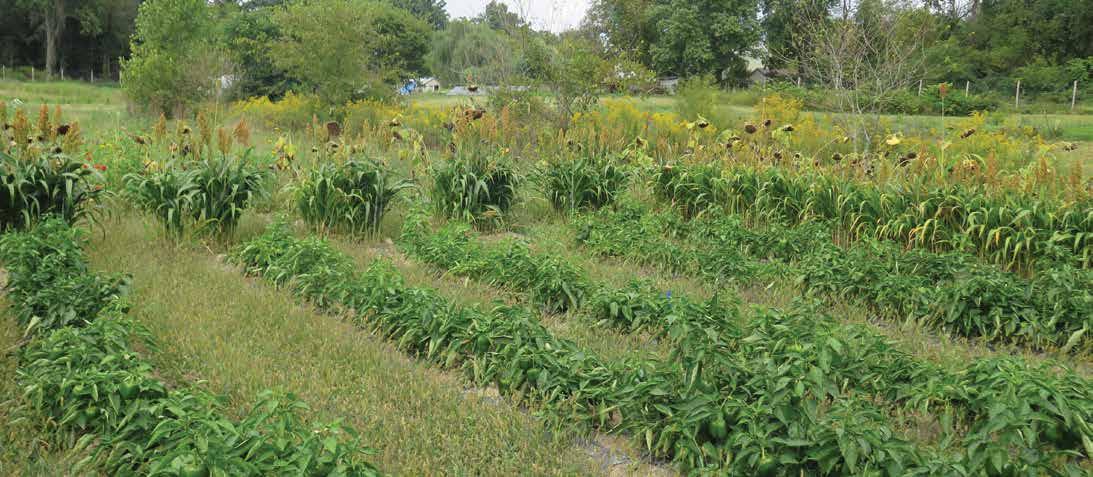
One tool for responding to a pest is biological control – the intentional release of a natural enemy for controlling pest populations. The history of biocontrol in New Zealand is extensive with many biocontrol releases being an insect for the control of an invasive weed (for example Honshu white admiral butterfly for Japanese honeysuckle) or a small parasitic wasp for the control of an insect pest (for example Tamarixia triozae for tomato potato psyllid (EPA, 2023)).
The use of biocontrol is not a guaranteed solution for eradicating an unwanted pest, but instead is a tool that can assist with controlling pest populations. Biological control is important as it offers a chemical-free, costeffective, and self-sustaining tool that can provide ongoing management of the target pest (Jaiswal et al. 2022). It can also potentially be used in locations where use of chemical tools would be difficult, such as near waterways.
Biopesticides are derived from naturally occurring biological organisms or substances and can be another effective biological tool for managing or eradicating pests (EPA, 2022).
There are two main biopesticide classes:
• Biochemical: controls pests through non-toxic means e.g., chemical lures on traps or mating pheromone disruptors, for example Queensland fruit fly trapping in Auckland in the successful 2015 eradication response (MPI, 2020).
• Microbial: contains natural enemies of the pest, for example a bacteria or fungus in a liquid which is then sprayed in the target pest area.
Gabi Hidvegi : HortNZ risk policy advisorAdvantages of using biopesticides include specificity to the target pest, being efficacious in small quantities and being non-toxic and more efficient at biodegrading than conventional pesticides (EPA, 2022).
Chemical biosecurity tools involve the intentional application of pesticides for the control or eradication of a pest. During a biosecurity response, chemical pesticides (with the appropriate approvals) offer biosecurity officials an effective tool capable of rapidly controlling target pests. Application types can include:
• Sprays – spray bottle or canister for flying insects in localised areas
• Certified operators with knapsacks
• Fumigation – gas or vapours to kill pests in an enclosed space, for example containers
• Helicopters and drones – aerial discharge of chemicals over targeted areas, for example individual treetops
• Aircrafts – more extensive aerial spraying.
The choice of application method is dependent on many factors such as the type of pest (for example pathogen vs insect vs weed), level of infestation, environment (for example productive land vs urban vs native estate), location, health and safety and regulatory guidelines (Deskera, 2023).
Each of these application methods have their advantages and disadvantages. For example, spraying by aircraft enables the operator to cover a much larger land area than targeted spraying by a drone. However, the potential for adverse impacts to any susceptible non-target organisms is greater as the spraying is not targeted to individual trees (Chagnon et al. 2015).
During a biosecurity response, time is critical and chemical tools can be the difference between a successful eradication attempt or not. Pesticides are an important tool as they are relatively fast-acting, efficacious against the pest, and versatile as they can be applied using different methods.
Cultural tools refer to the physical and mechanical practices used by people to change the environment to make it undesirable for pests and diseases. These tools and practices can include:
• Crop rotation to distance a soil pathogen from the susceptible host
• Removal of weeds by hand or controlled burn-off
• Pruning of infected plant material or removal of host plants
• Grazing stock for weed consumption
• Removal of ‘waste’ fruit from crops to prevent pest reservoirs
• Humidity control to make the crop environment unsuitable for pests or pathogens to thrive
• Trap crops to lure pests away from the primary crop.

Cultural tools such as host removal can be critical in a response as it changes the suitability of the environment for a pest that is reliant on one type of crop. For example, the pea weevil was discovered in Wairarapa between 2016 and 2017 and was successfully eradicated through a number of cultural tool methods such as banning the movement of pea products out of the region and halting pea production, which effectively starved the weevil population (MPI, 2023). Trap crops can also be used to lure large numbers of pests to a favourite host where they can then be collected and treated or removed from the population.
Cultural tools can be longer-term, for example crop rotation, or can have immediate, observable benefits, for example the physical removal of weeds. Other benefits include long-lasting impact such as stock continuously grazing to consume new weeds before they set seed. Cultural tools are generally environmentally friendly compared to conventional agrichemicals as no chemical application is required (Bugwood, 2012).
In many instances two or more of these tools are used simultaneously to maximise the chance of eradication or long-term management success. The use of multiple tools can improve the outcome by targeting different life stages of the pest, removing individuals from the incursion population, knocking down mobile life stages to prevent further spread, making the environment at the site of detection less favourable for establishment and preventing mating. In many cases, using an integrated approach lessens the chance of the pest establishing. If it does establish, a combined approach can slow the spread and reduce the impact of the pest.
Many growers are familiar with integrated pest management and will use a range of the above tools in their usual production practices. The same types of tools are deployed for biosecurity incursions, and all are important for protecting our sector from exotic invaders.
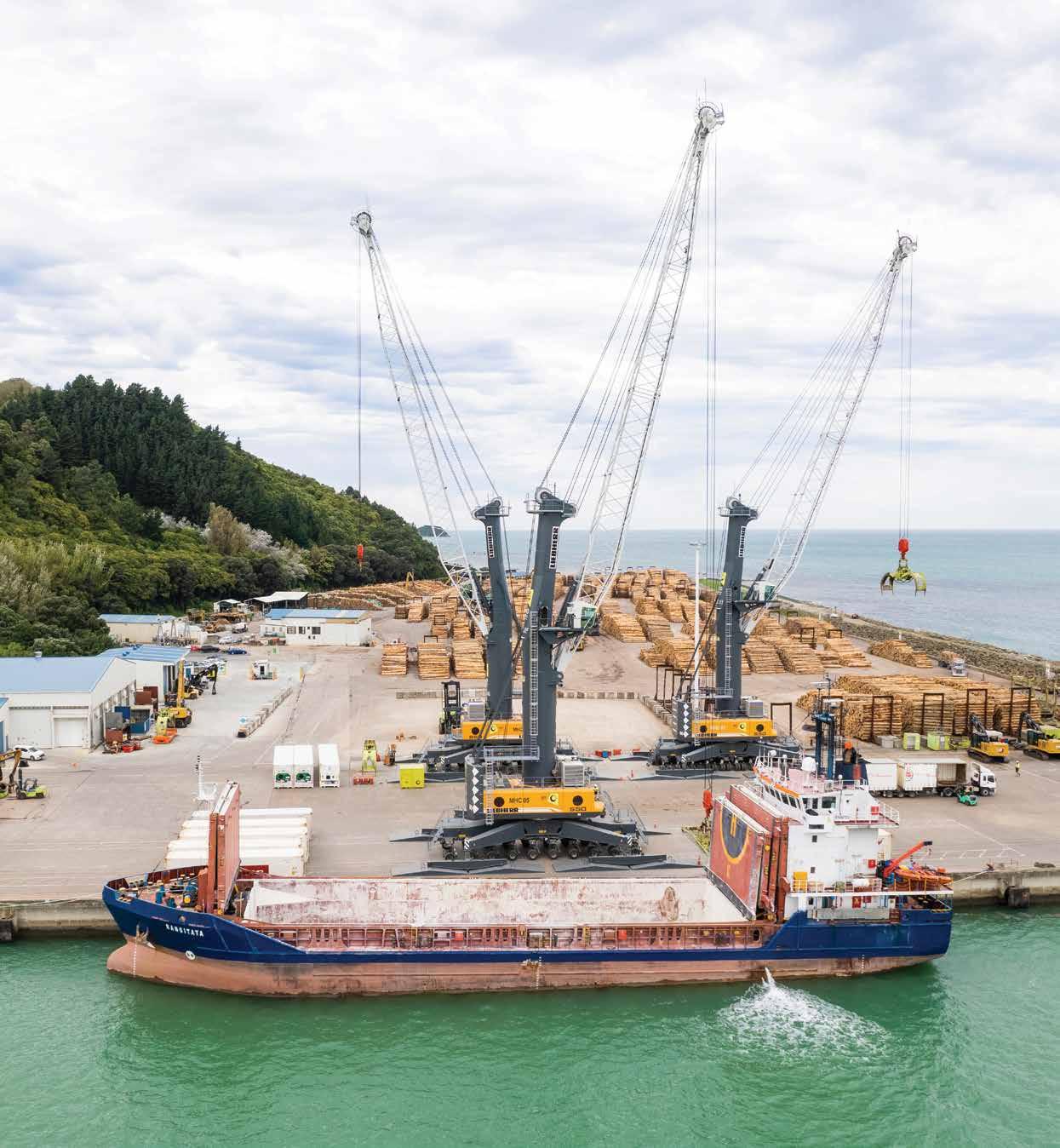
“I’m a horticulturalist. I can’t help myself. I will always be growing something,” says Geoff Langford, renowned New Zealand berryfruit scientist. He has recently sold his company Berryworld, the business he founded in 2012, to plant scientist Molly Shaw who joined Berryworld in 2020.

“I will continue to work with the company doing some of my favourite projects and mentoring Molly, and if I can continue to help growers in any shape or form, that’s what I want to do,” says Geoff who, after more than 60 years involved with the berryfruit industry, can’t imagine doing anything else.
Geoff formed Berryworld to specialise in research and development at an industry level, following around 45 years of active involvement in the formation, maintenance and future direction of a number of New Zealand’s berryfruit industries, while working as a scientist for MAF (the former Ministry of Agriculture & Fisheries), Hort Research, and Plant & Food Research.
In the 20 years since, he has continued to play a significant role in the berryfruit industry, including breeding new varieties and carrying out research into management practices and pest and disease controls.
“My focus has always been helping growers with whatever technical production aspect is the biggest issue. That has meant a strong focus on pests and disease management, and I still enjoy identifying issues and working out solutions for them.
“I think the biggest opportunity comes with new varieties, and that will continue to be my focus for the future.
“From a legacy perspective, all but one of the blackcurrant varieties grown in New Zealand are part of my history and I am very proud of that. Running the strawberry variety trials is always good fun and there are some very exciting new ones coming through the system.”
Geoff has worked with all commercially grown berryfruit industries in New Zealand. He was the government representative on the former Raspberry Marketing Council which operated under the Primary Products Marketing Act.
“The big growth surge in the berryfruit industry happened in the early 1980s and I helped set up the blackcurrant, boysenberry and blueberry organisations. Once Berryfed (the Berryfruit Growers’ Federation) split up, I became very involved with the strawberry organisation as well as the others.”
Hopes were high then for the future of the New Zealand berryfruit industry. “None of them has turned into the next kiwifruit, despite predictions from some people back
in the 1980s. The fact that they are all still in business suggests they have all had a degree of success.”
Among the highlights of Geoff’s career are breeding new blackcurrant varieties and solving the mystery of the boysenberry decline disease that was wiping out the industry.
“In the early 1980s in Northland, Auckland and South Auckland, a disease showed up rendering the fruit sterile.”
The symptoms included stunted multiple shoots emerging from individual buds (witches’ broom) and deformed flowers from which fruit did not develop normally.
“It looked like classical phytoplasma symptoms and we spent three to four years trying to find an insect which was spreading it. Then I had a visitor from the Scottish Crop Research Institute Station who asked if we had tested for Cercosporella rubi infection. We had, but did so again and C. rubi was confirmed.”
The fungal infection was successfully treated with existing products and the disease stopped in its tracks in the Bay of Plenty. “We made a lot of boysenberry growers very happy. However, the disease is still around.”
Among the new blackcurrant varieties Geoff has bred to cope with less winter chilling, is one now being grown in the West Midlands of Britain.
“Blackcurrants have a good future because of the relatively low labour input, but in international markets there are constant changes that are always impacting in unpredictable ways.
“Blackcurrants are at the forefront of climate impacts. When I started there were a number of operations in the North Island which have all gone. Nelson is marginal for a number of the commercial varieties, and our focus is to breed new material with lower chill requirement.”
Geoff doubts the industry will use chemicals to promote budbreak. “Given the whole focus of blackcurrant is its health status, growers must be careful what chemicals they choose to use. They would not want to destroy the fruit’s image.”
Constantly breeding for a changing climate is vital if the industry is to survive, but Geoff says it takes at least ten years to bring a new cultivar to market. “We don’t use genetic modification, and while CRISPR gene editing may be used in future, it requires a decent amount of money to develop, and berryfruit are such a minor crop the funds aren’t there.”
Growing berryfruit under cover will be increasingly prevalent. “Trends would suggest indoor production takes out some of the risk, but each production system still has challenges. Getting good returns for high value crops like fresh berries is going to be essential because of the high labour requirement.”
There are no berryfruit varieties named after Geoff, and for good reason: “There is a risk with that. If they turn out to be no good, that is not a good advertisement for you. As an example, I named a blackcurrant variety Ben Mapua and it turned out to not work commercially.”
The name of the not-so-successful blackcurrant was no doubt influenced by where Geoff grew up –Māpua, in the Tasman District, famous as an apple growing region.
“I am part of the Paynter fruitgrowing family, but my uncle was one of the first boysenberry growers in the country. He paid better than Dad, so I have been involved with the boysenberry crop for more than 60 years. The other reason was that John Wilton got the apple specialist role ahead of me. Then the Berryfruit specialist role became available so that suited me just fine.”


Our longevity and in-depth involvement within the horticultural industry allows our Research and Development team to work on the issues that matter the most to vegetable growers in New Zealand.

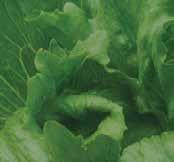


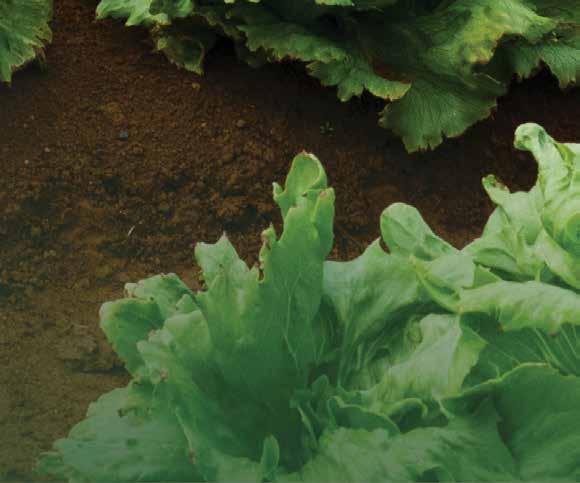
Our local trials look at ways to improve environmental impact and productivity, and combat pests and diseases. They provide growers with innovative products that are backed by reliable in- eld data and an understanding of how they’ll t within a complete crop management programme.

Nearly three months have passed since Cyclone Gabrielle wove its path of destruction across the country, hitting Hawke’s Bay, Tairāwhiti, Bay of Plenty and Northland. The recovery is a longhaul effort. In this issue, HELENA O’NEILL finds out how

It’s been a busy time for the Northland Rural Support Trust as they work in rural communities across the region in the wake of Cyclone Gabrielle.
Northland Rural Support Trust chair Michelle Ruddell says the trust’s mission is to ensure rural communities are supported. The branch covers from the Auckland Harbour Bridge to the Far North, so it’s a diverse area.
On 21 March a 103mm downpour between 4am and 5am in Maungatapere set a national record for the biggest dump of rain in a single hour for a low-elevation weather station.
Farms in Riponui, Pipiwai, Purua and Ruatangata to Titoki were also affected. The heavy rain also caused flash floods that destroyed fences, set off slips, and scattered debris across farmland. The Northland Rural Support Trust gathered volunteers to help clear and repair damaged areas.
The trust is already working with Northland avocado growers, the Maungatapere area particularly hard-hit by Cyclone Gabrielle and then hit again by the heavy downpour in March. The trust is providing phone support and getting some growers on the list to have Enhanced Taskforce Green to come in with the clean-up.
Enhanced Taskforce Green provides funding to councils or other authorised agencies to employ jobseekers to assist with clean-up activities following an adverse weather event or natural disaster.
The council or agency ensure the workers are adequately trained and supported to complete the tasks and have the necessary tools, equipment and clothing to do the tasks that are required.
Michelle says that in the two weeks following Cyclone Gabrielle, the trust co-ordinated six collaboration dinners across Northland, with another five in April. They also have AgFacilitators on the ground providing one-on-one support.
“We started with six AgFacilitators and have built our capabilities to 12 AgFacilitators. We are running a mentor programme with our experienced facilitators mentoring our new ones.”
and the ongoing impacts that will last many months and seasons,” Michelle says.
Andre de Bruin has been growing kūmara near Dargaville for more than 25 years. He says that a lot of the damage caused by heavy rain and Cyclone Gabrielle is invisible to the casual observer due to the nature of root vegetable crops like kūmara.
“The hardest part for us is that when we look at the paddock, it looks fine. When you look out over our fields at what we haven’t harvested, it looks just like a normal kūmara crop to the untrained eye.
AgFacilitators have been allocated a caseload where they call, visit and deliver care packages to all kūmara growers in the greater Dargaville area. With available resources, they share information with the growers from the Ministry of Social Development and Ministry for Primary Industries.

“Our AgFacilitators are ensuring they offer their support to all in the business who may need it, and recognise the complexity and enormity of the challenges that our kūmara growers face immediately following Cyclone Gabrielle


“At the end of the day, you’re in the growing for the good years and the bad years. And bad years come in different shapes and different sizes: this is one that tests most people. There are one or two growers who are not that heavily impacted. They’re lucky, but that’s the nature of these events.
“Some of our growers have completely lost all of their crops, and all of their seed. Growers in that position have an awful lot to deal with going forward. It will be a very expensive return to the industry. I really feel for them.”

We have quite a reasonable post-harvest industry here and you certainly feel for them and their employeesGrowers Janene Franklin and Deb Adolph at a dinner organised by the Northland Rural Support Trust
Andre says it has been heartening to have people come to Northland from right around the country to help growers, and equally encouraging to see skilled Northland people helping those affected by Cyclone Gabrielle on the east coast.
“From up here we certainly sympathise with our industry colleagues down in the wider Hawke’s Bay area and the situation that they’re facing.”
Unlike Hawke’s Bay, Northland didn’t have serious issues with silt, although it did block subsurface drainage for some growers.

“I had a metre of water go over some of our crops and there was no silt in it. So a day after the water was gone you say ‘where was the flood?’ A casual observer would say that nothing really happened. Our growers have been digging, and there is a lot of rotten kūmara underground.”
Andre is also concerned about how well the kūmara would store before getting to shelves over the coming months.
“By the middle of May, we will know how much kūmara we have. Right now, we still don’t know how it’s going to store. There are some in storage that look quite good, there are some that you can already tell are not going to make it. Some growers are going to be surprised with how poor their kūmara will pack out. With others, they will pack out beautifully. There will still be some really good quality product to go out onto the shelf, it’s just going to be short.”
The post-harvest industry is also taking a hit due to the huge drop in kūmara going through packhouses, Andre says.
“The packhouses have taken the brunt of this as there just won’t be the volume of kūmara going through. We have quite a reasonable post-harvest industry here and you certainly feel for them and their employees. It will have an impact on a rural community like ours.”
At the end of March, Radio New Zealand (RNZ) reported that Kaipara Kūmara in Ruawai normally washes, grades and packs about 7000 tonnes of kūmara per harvest. This year it is tracking to less than 2000.
Managing director Anthony Blundell told RNZ that the business was ”managing the best we can and topping up people’s wages, understanding the fact that in January 2024, we’ll be harvesting the 2024 crops so we’ll need everyone back on board“.
Consumers must remember that kūmara is an annual crop with one harvest season, so the supply issues will remain for at least the next year, Andre says. If people want to help support kūmara growers, then keep buying kūmara.
“The price is such because the volume is down. If you’re able to fit it into your budget, then adding kūmara to your dinner is a wonderful thing.”
21 MARCH A 103MM
BETWEEN 4AM AND 5AM IN MAUNGATAPERE SET A NATIONAL RECORD FOR THE BIGGEST DUMP OF RAIN IN A SINGLE HOUR FOR A LOW-ELEVATION WEATHER STATION
High quality export onion.


Long storage onion with excellent shipping potential.
Uniform globe shape bulbs with good size uniformity, firm with very good skin quality.
Vigorous ELK type with strong plant growth.
Uniform in size and shape with the majority in “Medium” size grade 70-90mm.
Very firm bulbs with excellent skin retention and storage potential.
Excellent pack-outs. Reliable performer over many years.
Strong against bolting.
Maturity approximately 10 days later than KiwiGold.
Upper North Island Alan McKee, Mobile: 021 956 701, Email: alan.mckee@tnseeds.com
East Coast & Manawatu Graeme Jackson, Mobile: 021 396 359, Email: graeme.jackson@tnseeds.com
Ohakune & Horowhenua Kathryn Wells, Mobile: 021 475 482, Email: kathryn.wells@tnseeds.com
South Island Roger Banfield, Mobile: 021 352 764, Email: roger.banfield@tnseeds.com

Auckland/Protected Cropping Ingrid Ennis, Mobile: 021 435 493, Email: ingrid.ennis@tnseeds.com
www.terranovaseeds.co.nz
Freephone: 0800 TERRANOVA (0800 837 726) Customer service: Ph: 09 275 1919 Fax 09 275 2021
They’ve seen some teething problems, but the newly-established coastal shipping service out of Gisborne will only get better over time, Eastland Port says.
The ‘blue highway’ is not the perfect transport solution for all growers, but it is a pretty good one that will get even better over time, says Gisborne container service operator Eastland Port.
In early April, just three voyages into its new GisborneNapier container service, the MV Rangitata was stuck offshore due to bad weather, a wait compounded by the shipping queue that had formed.
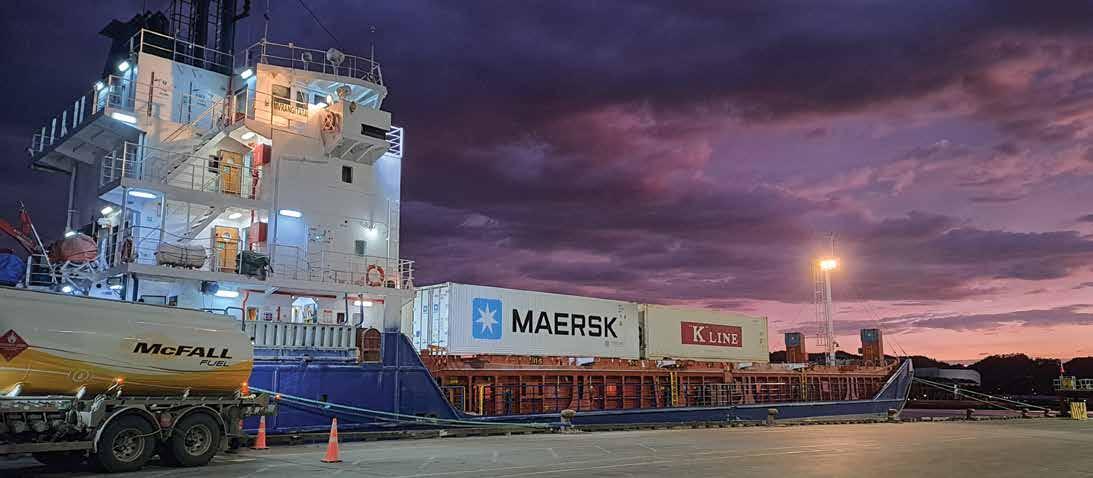
That meant local grower LeaderBrand – one of two customers using that run of the container service – had to collect its squash and truck it to ‘catch the boat’ when it berthed at the Port of Tauranga.
“From the outset we knew there would be teething issues given this project was stood up in a matter of weeks post-
Cyclone Gabrielle,” says Eastland Port operations manager Andy Kinsella.
“Unfortunately, we are a surge-affected port and it is the environment we have to work in.
“It is early days for this service and we are working towards getting infrastructure and robust processes in place to help keep future disruption to a minimum.”
Getting the service up and running has been a sharp learning curve since the government in March approved a $500,000 grant (and $2.25 million underwrite) enabling Eastland Port to charter the Rangitata for a coastal shipping route between Gisborne and Napier.
The three months’ worth of funding was a response to the damage caused to the roading network by Cyclone Gabrielle, but Eastland Port had for years been eyeing a container service and hopes to expand it in the future.
However, it has been more than 40 years since Eastland Port has handled containers and Andy Kinsella says bringing the project forward so quickly means there are still some systems needed to ensure it functions in an efficient and resilient manner.
While the $2.25 million covers the vessel charter, crew, insurance and fuel costs at $750,000 per month, the $500,000 in capital funding has been used to accelerate the rebuild of Eastland Port’s Wharf 7 ($250,000), and for
infrastructure related to electrical connection points for reefer containers.
Putting the new service in place has also been impacted by an increase in overall demand, even as the kiwifruit season came to an end, he added.
For LeaderBrand chief executive Richard Burke, though, the hiccup with the company’s squash reignited his calls for more investment into the road network from Gisborne, which he sees as a more reliable option.
“If we hadn’t been able to truck our squash to Tauranga we would have missed our connection and that’s the problem with coastal shipping, you lose control and get affected by issues along the chain,” he says.
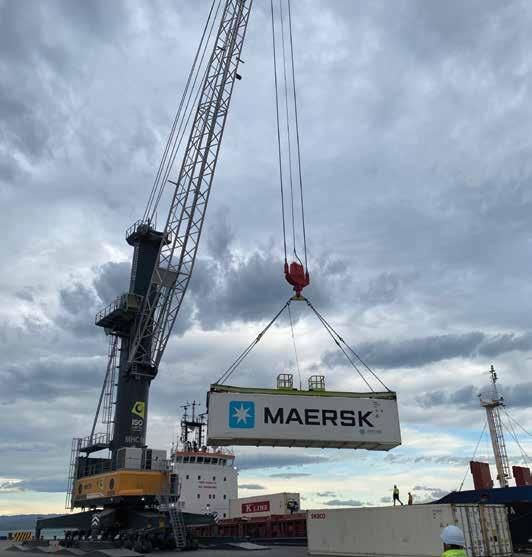
“We’ve had a tough season and it was really important that those last five containers (about 25 tonnes) of squash got to market in a timely manner.”
 The new coastal container service in operation. Photo by Eastland Port staff
The new coastal container service in operation. Photo by Eastland Port staff
Richard Burke says it is his preference to see investment in a road leading out of the district that was, as much as possible, immune to future weather events.
“While the road south (to Napier) is important to us, north (to Tauranga) is critical, and as there is already good investment north from Ōpōtiki, it would be the most practical,” he says.

“Our product is time-sensitive and an important part of the food supply chain, and we just can’t afford to be held up by scheduling issues.”
Despite those concerns, Andy says there is increasing demand for Eastland Port’s new container service.
When the service started on 21 March, LeaderBrand and two regional meat companies had been the primary customers, ‘dipping their toes into the water’ with just a few containers at a time.
But by mid-April that had already ramped up from an initial five containers to 13 and then to 32, “which is pretty much at capacity”, says Andy.
“Before the month is out we’re also expecting to get good volumes of apples on board and as interest is growing, we’re getting our processes well bedded in.

“We are supportive of investment in our region’s roading network and see coastal shipping as being a good complementary freight option for local growers, so it’s great to see some of them giving it a shot.”
The investment in container shipping at Eastland Port is part of a wider strategy launched in mid2022, when the government selected four preferred suppliers for coastal shipping services.
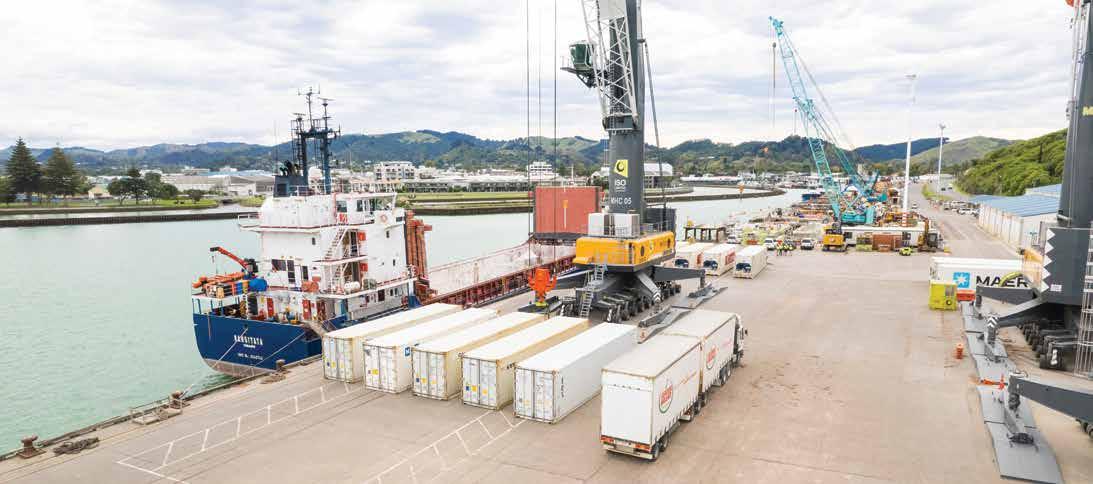
“Coastal shipping is a small but important part of the New Zealand freight system,” Transport Minister Michael Wood said at the time.
“This is why the government is investing in making coastal shipping a more viable alternative to strengthen and diversify our domestic supply chain, helping to secure New Zealand’s recovery from Covid-19.
“And as a lower emissions transport mode, investing in coastal shipping will also help us achieve our decarbonisation goals.”
Overall, through the National Land Transport Programme (NLTP) the Government committed $30 million for coastal shipping to improve domestic shipping services, reduce emissions, improve efficiency and upgrade maritime infrastructure.
The four preferred suppliers are Coastal Bulk Shipping (which services Eastland Port), MOVE International, Swire Shipping NZ, and Aotearoa Shipping Alliance.
Each is expected to bring at least one additional coastal shipping vessel into service, between them removing around 35 million kilometres of truck travel from New Zealand’s roading network every year.



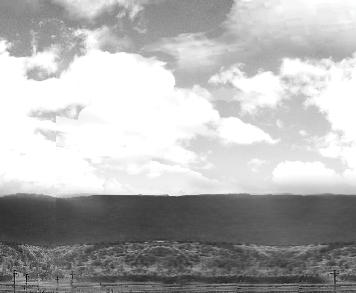







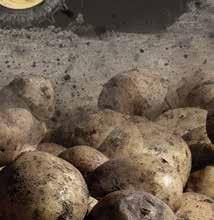




















The price the public pays for fruit and vegetables in New Zealand may not accurately reflect the level of risk involved in growing them, says vegetable industry leader, Robin Oakley, of Oakley’s Premium Fresh Vegetables of Canterbury.

That level of risk has been highlighted by the devastating impacts of Cyclone Gabrielle on the North Island’s growing regions, but Robin believes extreme weather events are just one of the risks growers face.
“I maintain that historically the prices growers have been paid for crops hasn’t reflected the true level of risk to their businesses.
“Recent weather events have highlighted some of those risks, but the level of risk has gone up significantly in the last two years, including inflationary impacts.
“Risk versus margins is out of kilter for a lot of growers and some may not have factored in weather event risks. Now these have eventuated, many growers may be reassessing the prices they need to get in order to continue to grow crops.”
That reassessment may mean some growers decide to leave the industry. “A lot of crops are grown on land close
to urban areas with the potential for subdivision. Growers who have had a rough time may be thinking of re-purposing the land to something else, and for the industry this is of concern.
“There may well be a gap between people pulling out, causing vegetable prices to go up, and people deciding to reinvest or invest in vegetable growing. The higher prices consumers are paying may go on for a bit longer than one might anticipate.
“I think we may have seen the best times of supply and price for vegetables in New Zealand but in reality, vegetable prices have only gone up along with everything else in these inflationary times.”
Growers in Northland and the Hawke’s Bay were among the worst affected by Cyclone Gabrielle which destroyed crops and closed roads, meaning even those who had crops to harvest, faced difficulty getting them to market.
Robin says Oakley’s and other vegetable growers were unable to step up production to meet the shortfall in produce caused by the cyclone.
“At the end of the day we only have our normal production and are growing and harvesting the same volumes of product as normal.
“It’s a supply and demand market, and the shortfall in product in the North Island meant higher prices, so more product from the South Island has gone north, which has had the effect of increasing prices in the South Island.
“For Oakley’s we have been involved more on the logistics front by sending product to different destinations than it would otherwise have gone to.”
Robin says because of the lead time required to produce a vegetable crop, there is nothing Oakley’s, or other growers can do to fill the gap in the market.
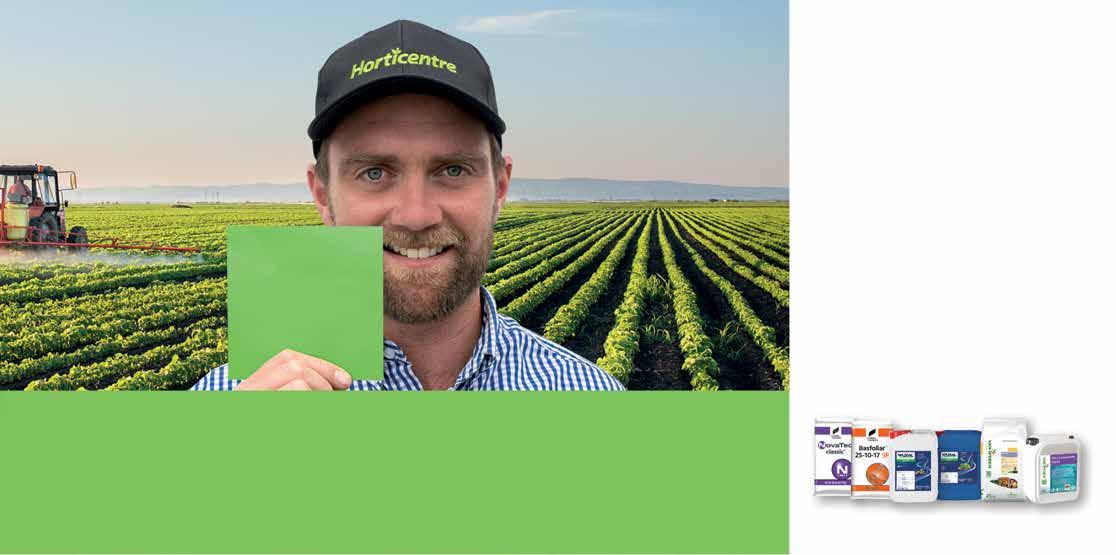
“Our potatoes, beetroot and pumpkin are annual crops with one growing season. With broccoli there’s a six-week lead time to grow the plants and even if we miraculously had more plants to get in the ground, here in the South Island it takes three to four weeks longer for the crop to mature than in the North Island.
“We don’t grow crops on a speculative basis that some region might have a weather event, and I don’t see us changing our planting programme in future.”
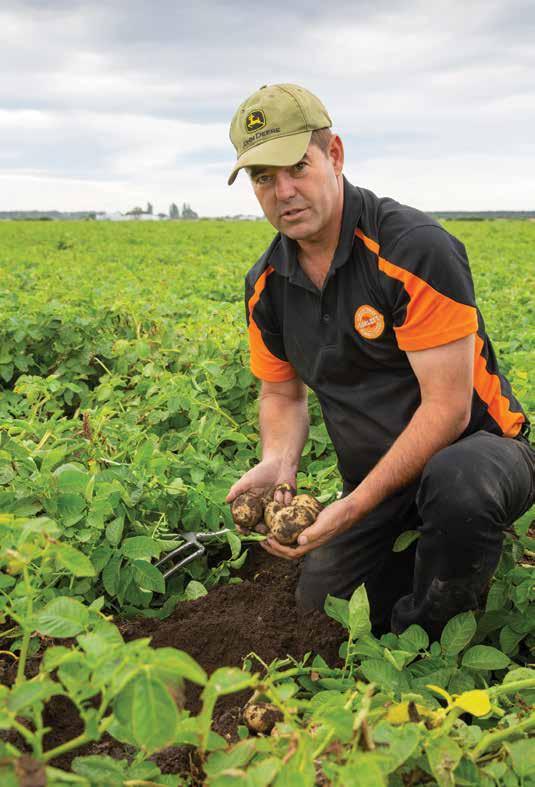 Robin Oakley of Oakley’s Premium Fresh Vegetables
Robin Oakley of Oakley’s Premium Fresh Vegetables
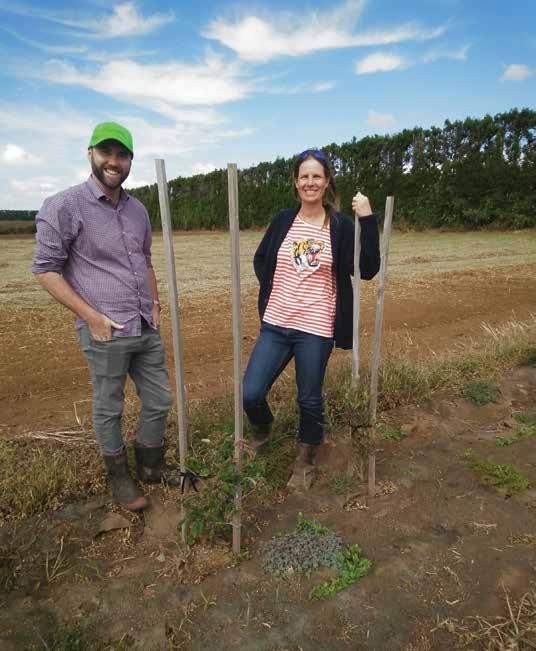
Olivia Prouse from Cropping Services Ltd is a consultant for Vegetables New Zealand working alongside Onions NZ on an A Lighter Touch project, carrying out demonstration work at the Pukekohe demonstration farm on Cronin Road. And she says that even in the short time since December last year when 300 metres of groundcovers started to be planted along drains around a four-hectare area, some promising results are being seen.
The end aim is to be able to provide growers with a list of suitable plants for different situations which they can use as a resource.
“It needs to be something which will help the whole growing system,” she says.
“Then they can pick what works well for them. The overarching theme is biodiversity. You can’t increase it in the crops, so you have to have it in floral mixes and groundcovers.”
Vegetables NZ is looking to show best practice on a semicommercial level on the demonstration farm which grows onions, broccoli, lettuce, pumpkins, sweet corn and barley in one-hectare areas in a set rotation.
“That’s so growers can take up new tools at less risk to them,” says Vegetables NZ’s newly appointed research, development and extension manager, Daniel Sutton. “They’re very reliant on crop protection, but housing biological control options on open fields is difficult. We hope this work will make these control strategies more sustainable.”
Vegetables NZ’s general manager, Antony Heywood, says the hope is that the project will be an icon for what the sector is planning to do with integrated pest management (IPM).
“It grounds us to a place and shows growers how these practices can be implemented,” he says.
A crop scouting workshop held there earlier this year was very popular and attracted 44 people.
Already small insects such as hover flies and soldier beetles are being attracted to some of the different species of groundcovers which have been flowering through the first three months of the year. And beneficial insect numbers are higher than pests where crops are growing closest to the groundcovers.
While the range of shrubs planted and staked in a 20m strip, which will grow into a hedgerow, haven’t flowered yet, Olivia is hopeful they will also prove attractive to beneficial insects. Groundcovers have also been planted underneath them to suppress weeds.
The aim of the plantings is to provide a permanent source of shelter, nectar, alternative food and pollen (SNAP) to attract and retain beneficials close to crops, as has been shown to be successful in Australia and in Foundation for Arable Research (FAR) research work carried out in the South Island. So growers, by following recommendations from the trial, will be able to increase biodiversity so there are more beneficial insects, fewer pests and less need for them to use insecticides.
Vegetable growers may soon be planting up more non-cropping areas with native groundcovers and shrubs in order to attract beneficial insects to their crops, but not pests.Glenys Christian Photos by Glenys Christian
As a base on which to establish the plants, wool mat, a biodegradable, locally-made product, was fixed to the ground with biopins to control weeds without using herbicides. It will break down completely over the next three years.


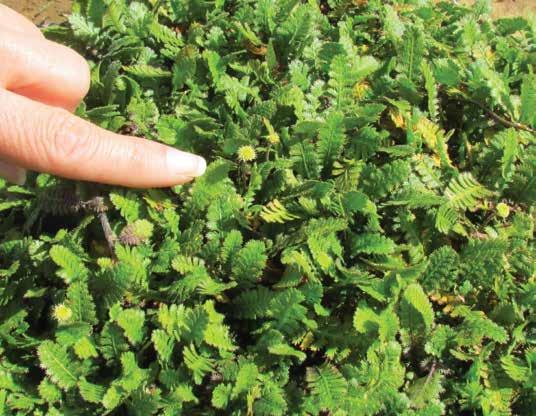
There are three different growth habits with the groundcovers; some spread over the wool mat, and some underneath, while others put up a single stem from which the rest of the plant grows. While some are already up to one metre across, they are unlikely to reach a height of more than 30 cm above the ground, so will present no problems for machinery turning at the end of a row.
As a result of flooding earlier this year, part of the lettuce crop was underwater on the demonstration area, leading to a disease outbreak.

“With the pumpkins a lot of soil washed down the wheel tracks and we thought we would lose the crop,” she says. “But they came through.”

Flooding also moved a large quantity of soil from crops on to the top of the wool matting, but it stayed firmly in place.
“We found that it suckered to the ground so there was less flood damage,” she says. “If we had used thin plastic, it probably would have been ripped out.”
To reduce run-off over the top of the wool mat, a bund could be created, with wool mat pinned down over the top and drainage channels cut through. Herbicide could be applied here to suppress weeds, removing competition
with the groundcovers, but this design would mean a drastic reduction in the amount used. The ground would be more stable and the cost of planting groundcovers might be matched by reduced chemical use. “It’s a mindset change.”
Monitoring of beneficial insects and pests by Plant & Food Research staff will be carried out as part of ‘A Lighter Touch’ (ALT) work, aiming to meet consumer demands for food produced using sustainable pest management practices with a lighter touch on the environment. The end result should be a list of native plants which work most effectively with different crops, provide a year-round food source and are tolerant to herbicides. To refine recommendations in the future, it is hoped to extend the range of plants being trialed, as well as the area on which they are grown. And Vegetables NZ plans to hold regular grower activities at the farm to show best practice and approach for growers looking to put IPM in place on their properties.
Of the groundcover plants at the demonstration site, Leptinella dioica and Muehlenbekia axillaris so far seem to be best at attracting small insects. The two shrubs out of the range planted which are showing the most promise in flowering first are Pomaderris kumeraho, also known as golden tainui, and Olearia cheesemanii, or tree daisy. But on the negative side, one of the groundcovers, Selliera radicans or remuremu, died during the January rains, as well as a couple of the shrubs also in a wetter area of the plot.
“We will be able to advise growers not to plant these species in areas unsuited to them,” says Olivia Prouse.


It’s early days yet, but the plants below show the most promise of attracting beneficial insects.
Groundcover
• Leptinella dioica
• Muehlenbekia axillaris
Shrubs
• Pomaderris kumeraho, also known as golden tainui
• Olearia cheesemanii, or tree daisy.
Alex Croasdale-Saunders has turned an interest in gardening into a career.
Alex studied the Fruit Production programmes at Toi Ohomai Institute of Technology and is now mentoring a current employee through his horticulture studies. Alex manages Pahoia Orchards and encouraged his 2IC (second-in-command), Darryan Andrews, to also study at Toi Ohomai.

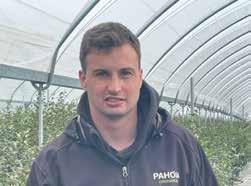
Alex’s time at Toi Ohomai gave him essential skills to help him build his career. And for Darryan likewise.
“The support from my tutors has been exceptional. Harmine and James have a very whānau mindset when it comes to our class, which I think is awesome,” Darryan says.
“Support from work has been great as well. I can

Whether you’re just starting out, working in the industry or managing staff who are looking to upskill - there’s a course option for everyone.
Fruit Production – July (Tauranga)
Horticulture – June, July (Rotorua, Tauranga)
Organic Primary Production – July (Tauranga)
Apiculture/Beekeeping – July (Rotorua, Tauranga, Taupō, Tokoroa)
Contact
0800 86 46 46
toiohomai.ac.nz
 Alex Croasdale-Saunders Darryan Andrews
Alex Croasdale-Saunders Darryan Andrews
“We need to plan for how we will cope with climate change,” says the retired onion breeder, who also has a small vegetable growing operation at Waiuku, southwest of Auckland.
Areas where cyclones or floods have occurred over the last century happen to overlay those of greatest horticultural production, so he believes growing is being carried out in areas where there is the greatest climatic threat.
“That’s not going to change, so we are going to have to grow vegetables in areas not subject to that.”
So the two options he sees for the future are to use soils of low value for food production or not use soil at all. He would like to see more research into low value soil improvement, and already has some small scale trials underway on his own farm.
He is experimenting with growing vegetables such as beetroot in sub-soil instead of topsoil to show how less fertile soils might be used more for vegetable production. This builds on his more biological approach to food production, where his mantra is “Don’t treat your soil like dirt”.
While some strategic chemical applications will still be needed, blanket spraying is a thing of the past on his property. And while he’s a small grower, he says some of the changes he’s made already are practical for large growers. It might require a mindset readjustment regarding production areas in order to cope with weather disasters by spreading the risk.
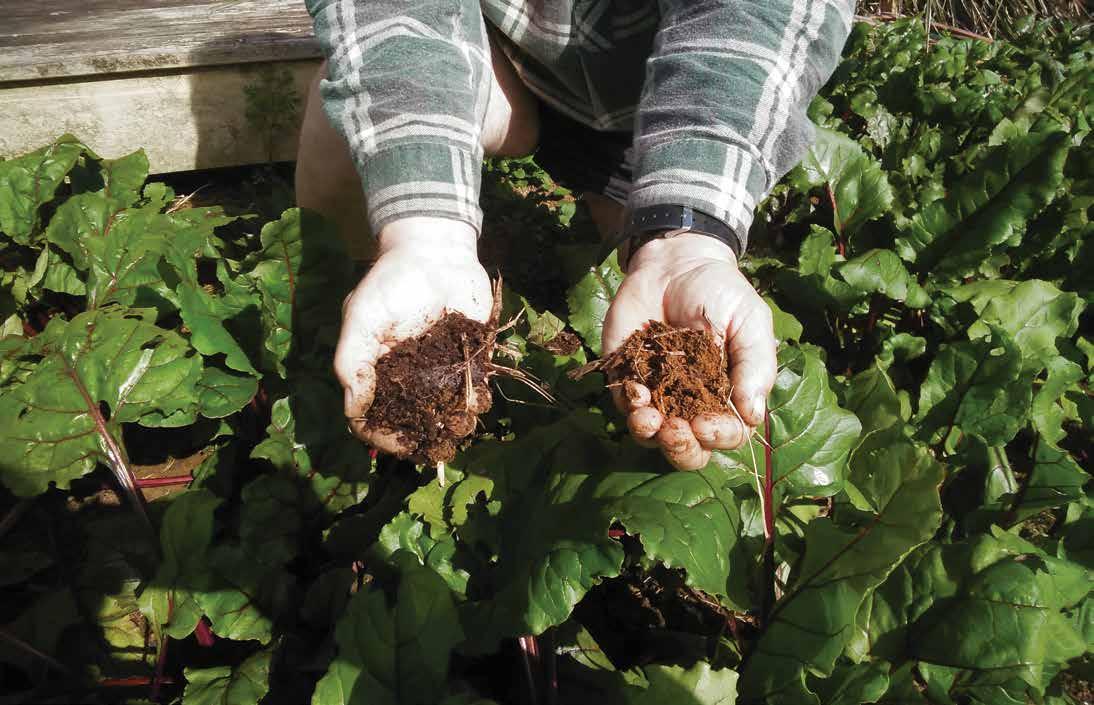
“Growing part of the production in regions with soils of lower value for food production but with a lower climatic extreme risk may need consideration,” he says. And he believes that producing scientifically proven data is the key to growers making the change.

The structure of Waikato ash soils breaks down in three years, as opposed to some Pukekohe soils which are regarded as being indestructible. So minimum tillage is the key, as chisel ploughing, power harrowing or rotary hoeing is further destroying the soil, he says.
“Plants need to be growing in a living soil, not a dead soil. We need to improve what we’re doing with compost and earthworms.”
He drills holes over a foot deep, adding lime and fertiliser and then compost which he buys in. If the holes fill up with water he drills them deeper then sows seeds. He never leaves bare ground, preferring to keep it continually in

Excellent spring harvest crisphead variety, suited to mid September – mid December harvest dependent on region. Dark green well wrapped head. Clean butt and nice internal colour. Flat round shape. Resistance to Bl 1-36 and Nasanovia.
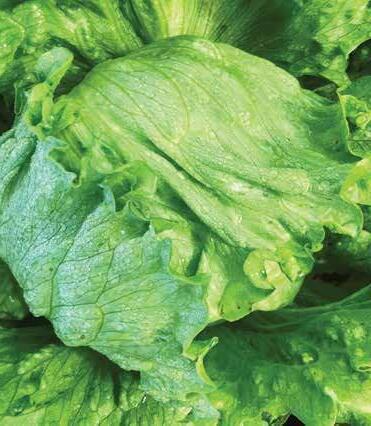
15-20 gm cherry presented on beautiful fishbone truss. Round fruits are bright red, and tasty. Great post harvest shelf life. Excellent continuity of production and earliness. Productive. Loose or truss pick. HR: ToMV:0-2, Fol:0-1,IR: Ma,Mi,Mj, TYLCV
Bicolour sweetcorn: Uniform 20cm cob with good tipfill. 80-85 days to maturity. Excellent presentation with good flag and husk cover. A nice easy snap makes Launch the perfect fresh market variety. NZ produced seed. Great disease package. HR: Ps, Rp1-d,g,f,j, IR: Et, MDMV
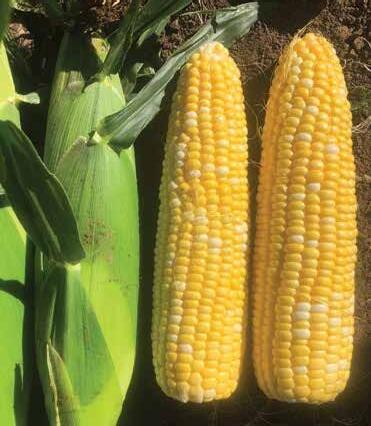
crop, and his almost full-grown celery plants don’t have a single Septoria spot despite having no sprays applied, not even a herbicide.
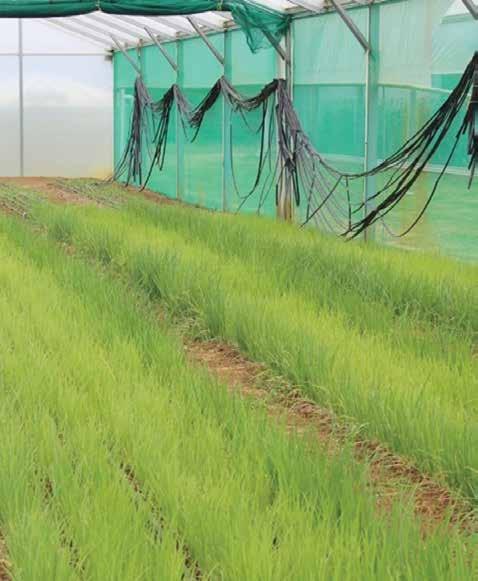
On a larger-scale sloping growing area of around one hectare, where he lost no vegetables in the recent floods, he’s moving to permanent beds, letting weeds grow in the middle of the rows so water doesn’t run down the wheel tracks. “That prevents erosion far better than anything else.”
He rotary hoes up land once a crop comes out, but only to a depth of five centimetres, leaving the trash on top.
“The deeper you cultivate the soil, the deeper you have to go, and that won’t work on low value soils,” he says.
There’s an area of permanent grass at the bottom of the slope, as well as a sediment trap he put in 20 years ago but has never had to dig out.
He sells a range of produce at the Pukekohe and Pokeno markets and regular customers remark on the intense flavour of his vegetables.
“I don’t apologise for either their quality or price, which is close to that of supermarkets,” he says. “Growing methods which are truly sustainable are needed.”
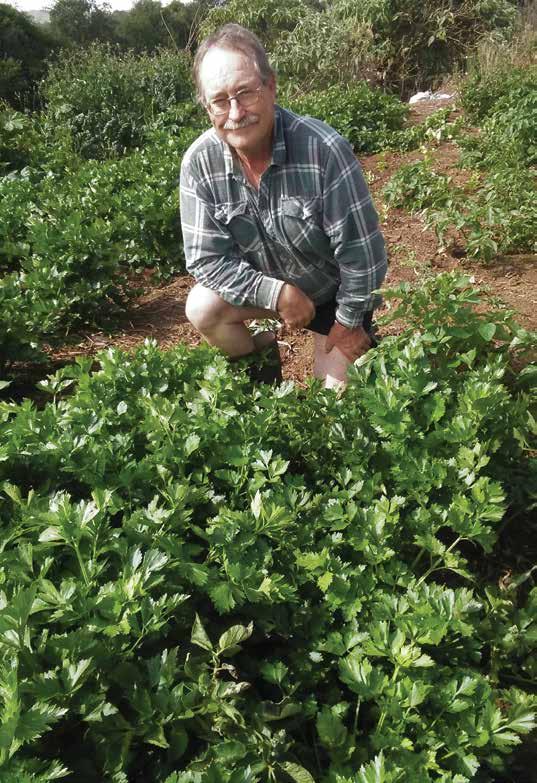
Using onion sets instead of seed proved its worth during the bad weather earlier this year, as the resulting crops had already been harvested. Martyn Callaghan and retired scientist, Mike Nichols, have been involved in the project, which they believe is a more sustainable practice, for the past five years (NZGrower, May 2022, page 15).
Small onions weighing from three to ten grams are planted from late September to November and harvested in January in the North Island, or February in the South Island, a 90-day growing period compared with 220 days from seed to maturity with Early Long Keeper onions in Pukekohe.
“They jump out of the ground and develop big, thick roots,” Martyn says. “And they also avoid onion smut and white rot as the soils are too warm. It’s a very practical system and yields are similar.”
Last year they funded trials at Pukekawa, north Waikato and at Twyford in Hawke’s Bay, both of which avoided flooding before and after Cyclone Gabrielle. Based on the results, one organic onion grower is interested in growing from sets to avoid winter weed issues. And a Feilding grower, whose sons are joining him in his business, wants to expand his operation and sees sets as a viable option.

HortNZ is calling for nominations for its 2023 Awards to be presented at the Horticulture Conference Gala Dinner. HortNZ will present up to one award in each of the following categories each year.

BLEDISLOE CUP
Awarded for an outstanding and meritorious contribution to the New Zealand horticulture industry.
PRESIDENT’S TROPHY
To celebrate and develop inspiring leadership within the horticulture industry.
INDUSTRY SERVICE AWARD
To recognise people with long and dedicated service in a supplier or service role (not a grower) that have worked beyond the call of duty for the betterment of the horticulture industry.
ENVIRONMENTAL AWARD
To recognise a person, or organisation, that has developed and implemented a sustainable environmental project, with identifiable benefits.
HORTNZ LIFE MEMBER
To recognise growers with long and dedicated service as office holders of H ortNZ and/or an affiliated Product Group or affiliated Grower Association.
Full criteria for the above awards are available on the Horticulture New Zealand website or can be requested from the Board Secretary.
Who can make nominations?
• Any grower member of HortNZ, an affiliated Product Group or an affiliated Grower Association can make nominations.
How do I nominate someone?
•Complete a nomination form. These are available on our website www.hortnz.co.nz or can be requested from the HortNZ Board Secretary via email admin@hortnz.co.nz or by phone 0508 467 869
When will the awards be presented?
•At the 2023 Horticulture Conference Gala Dinner on Wednesday 2 August 2023 at Te Pae Christchurch Convention Centre
When do nominations close?
•Nominations must be sent to the HortNZ Board Secretary, via email admin@hortnz.co.nz or PO Box 10232, Wellington 6140 and must be received by 5.00pm on Tuesday, 6 June 2023.
Send
The 5+ A Day Charitable Trust continues to promote fresh fruit and vegetables to encourage all kiwis to eat 5+ A Day – five or more servings of fresh vegetables and two of fruit for great taste, variety and good health.



We have helped build 29 vegetable gardens in Auckland schools so far through our partnership with the OKE Charity. We believe by providing tamariki the opportunity to grow their own fresh vegetables it will encourage them to try them and go on to enjoy them for life.

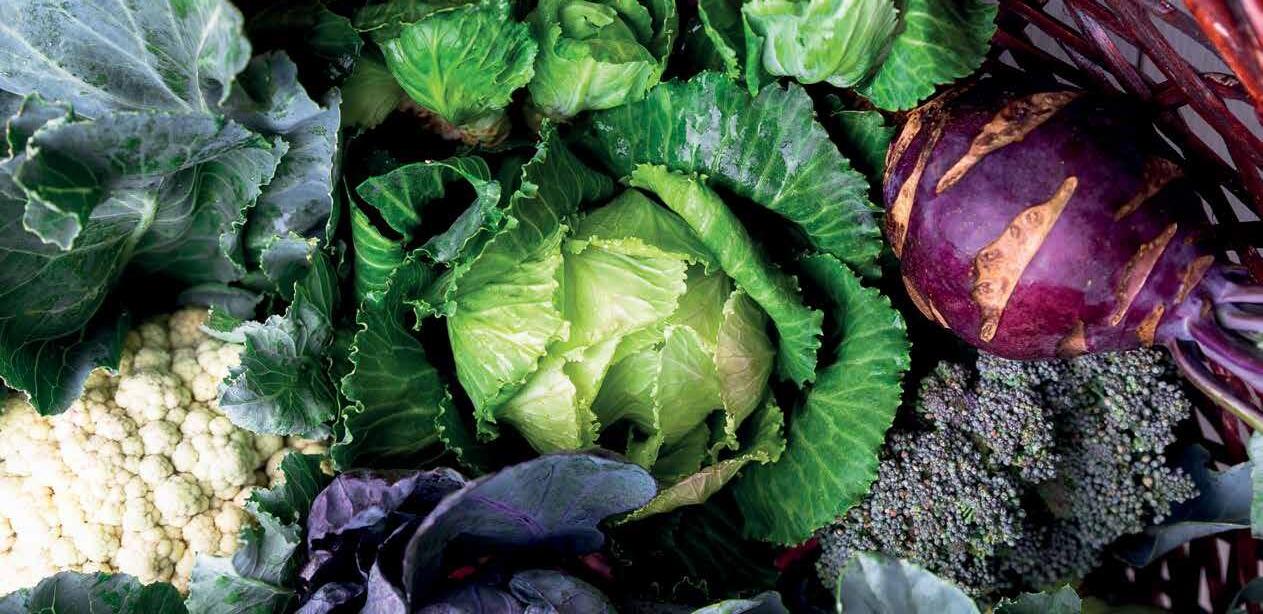
Here are the numbers:
29 gardens built in 29 schools
18.250 tamariki have access to the school gardens as a learning opportunity
4,500 volunteer hours provided to build the gardens

1,000kg of produce grown across our school gardens
We have produced some 15 second television commercials that started on TV3 last month promoting autumn fruit and feijoas. This month we have our persimmon commercial showing followed by winter produce in June.
You can check them out on our social media platforms by following @5adaynz
Our partnership with Dame Lisa Carrington continues throughout 2023. Lisa is an Olympian, World Champion and Halberg Sportswomen of the Decade and a fresh fruit and vegetable advocate.

You will see Lisa promoting fresh fruit and vegetables on our social media platforms throughout 2023. We continue our work with the Life Education Trust and the Two Raw Sisters giving us the ability to get in front of students with fresh workshops. The workshops give practical advice and tips on preparing fresh fruit and vegetables from breakfast fruit smoothies to vegetable Pad Thai. New resources have been developed for educators and students to keep the momentum going after the school visits.
In January this year we sent Early Childhood Education kits to Early Childhood Education Centres nationwide.
Our education resources are centred around tamariki learning about fresh fruit and vegetables in fun and interactive ways. Resources included seeds kindly sponsored by United Fresh member South Pacific Seeds, puzzles, posters and food texture guides produced in partnership with the Heart Foundation.
Our communications strategy for this year is focused on the value of fresh fruit and vegetables with the objective of changing the narrative around cost. In season fresh fruit and vegetables are always the best value and our seasonal promotions build on this by providing recipe and serving inspiration.

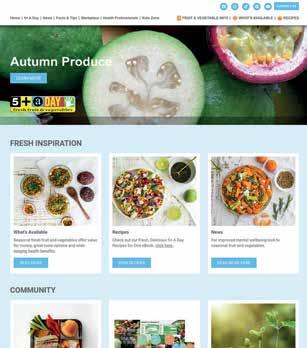


Did you know we have two websites? One for consumers www.5aday.co.nz and one specifically for educators www.5adayeducation.org. Be sure to check them out to find out more about 5+ A Day and our activities.


For more information visit www.5aday.co.nz, teachers and educators can access free resources on www.5adayeducation.org.nz
Follow @5adaynz on
THE LATEST INNOVATIONS AND IMPROVEMENTS
40 FALLOW PERIOD NITROGEN LEACHING

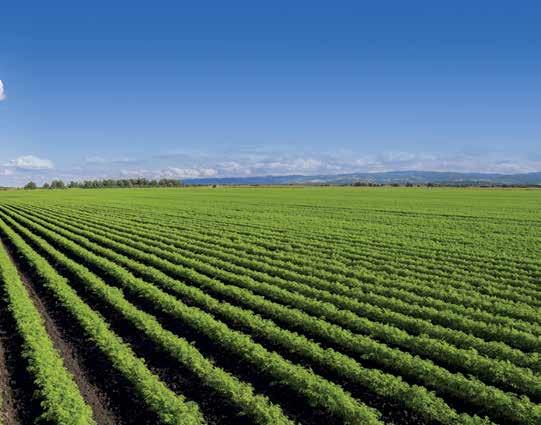 Georgina Griffiths : MetService meteorologist
Georgina Griffiths : MetService meteorologist


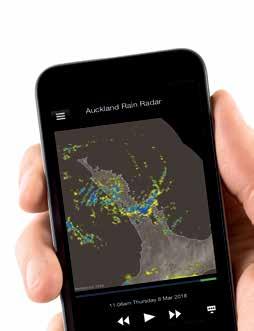
La Niña has ended, and the El Niño Southern Oscillation (ENSO) is currently ‘neutral’.
This means that local climate drivers, such as the Southern Ocean and Tasman Sea, will be in charge of the New Zealand weather maps through the rest of autumn and into winter. Global forecast models predict that El Niño is the most likely outcome for spring. A cold spring is the usual hallmark of El Niño here, with frequent southerlies across the country.
A ‘snapshot’ of estimated soil moisture deficit at 4km resolution
Valentine’s Day split Drying out in the north
The south gets a soaking Rain brewing
On 14 February the country was split by severe conditions at opposite ends of the scale








By 27 February the North Island’s moistureladen soils began to dry out
Frequent lows in the South Island created a very wet month, seen here on 21 March

In early April soils up and down the country seem dry but weather systems are brewing

South Island rainfall accumulation
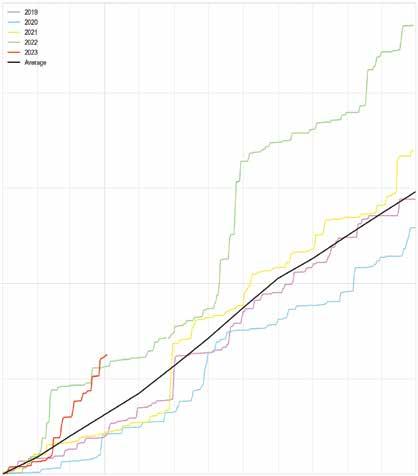
rainfall accumulation is shown in black. The year-to-date rainfall accumulation on 5 April 2023 was 250 mm, nearly double (196 percent) the year-to-date normal, and equates to 42 percent of the usual annual rainfall tally
rainfall accumulation is shown in black. The year-to-date rainfall accumulation on 5 April 2023 was 250 mm, very near (93 percent) the year-to-date normal. The March rainfall was a marked improvement on the relatively dry start to the year
was 221mm, or 102 percent of the year-to-date normal
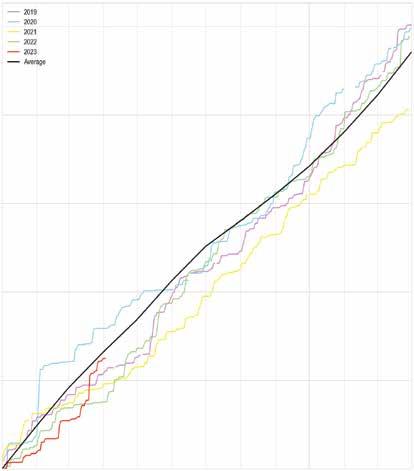


179mm, or 120 percent of the year-to-date normal





 Figure 3. Christchurch Airport rainfall accumulation (mm) for the last five years (2019 to 2023). The annual average
Figure 5. Nelson rainfall accumulation (mm) for the last five years (2019 to 2023). The annual average rainfall accumulation is shown in black. The year-to-date rainfall total on 5 April 2023
Figure 6. Blenheim rainfall accumulation (mm) for the last five years (2019 to 2023). The annual average rainfall accumulation is shown in black. The year-to-date rainfall total on 5 April 2023 was
Figure 3. Christchurch Airport rainfall accumulation (mm) for the last five years (2019 to 2023). The annual average
Figure 5. Nelson rainfall accumulation (mm) for the last five years (2019 to 2023). The annual average rainfall accumulation is shown in black. The year-to-date rainfall total on 5 April 2023
Figure 6. Blenheim rainfall accumulation (mm) for the last five years (2019 to 2023). The annual average rainfall accumulation is shown in black. The year-to-date rainfall total on 5 April 2023 was
We pulled this article together as we debated the significance of fallow periods on the risk to nitrogen leaching. Is a three-month fallow period riskier than two months in fallow, and if so, how much riskier? Then the flip side of fallow is how much does the use of cover crops reduce the risk of nitrogen leaching, or increase it?
Much of the focus on nitrogen use efficiency and leaching mitigation is placed on fertiliser management practices. However, the contribution to soil mineral nitrogen from crop residue breakdown can be significant, and in some cases can have a far larger effect on nitrogen flows through the system than fertiliser applications.
The impact of crop residues on potential nitrate leaching and on the nitrogen supply for the following crop can be dependent on the length and timing of the fallow period, among many other factors.
While adjusting nitrogen fertiliser application rates and timing to match crop demand is critical to ensure nitrogen use efficiency, accounting for nitrogen recycled in the form of crop residue is just as critical in maximising productivity and minimising losses. Management decisions on the treatment of crop residues, the length and timing of fallow periods, and the use of cover crops will be dictated by multiple factors, including climate, soil nutrient status, and the types of crops grown within the rotation. Therefore, growers need to understand the underlying patterns of residue breakdown and how nitrogen cycles within the soil in order to make the most effective management decisions.
Growers need to be mindful of the stores of nitrogen present in crop residues and consider how best to utilise these. With the increasing cost of fertiliser, it is becoming increasingly worthwhile for growers to put cover crops in during longer fallow periods (i.e., greater than three months), to lock in that mineral nitrogen until it is time to plant the next cash crop. Cover crops also provide the additional benefits of increasing soil organic matter and providing some erosion control. For shorter fallow periods, or after incorporation of a cover crop, the fertiliser management plan for a new planting should not only take
account of the mineral nitrogen currently in the soil, but also the nitrogen still contained within the previous crop residues, and consider the anticipated release rate of this nitrogen. This could initially even just be conservatively accounted for while knowledge grows around nitrogen release rates, with soil nitrogen testing used to validate those estimates during the growing season.
A recently prepared report by Plant & Food Research and funded jointly by the Foundation for Arable Research (FAR), Vegetable Research & Innovation (VR&I) and Potatoes NZ, A literature review of arable and vegetable crop residues, with emphasis on nitrogen status and factors affecting residue decomposition and nitrogen release, has established a good baseline of knowledge on this topic.

The exact dynamics of crop residue breakdown and mineralisation are complicated, with rates of nitrogen release dependent on multiple variables. Therefore, exact predictions of residue nitrogen release are difficult to make. However, certain factors can be accounted for to give a reasonable estimate of mineral nitrogen availability in the soil. The nitrogen budgeting tool, N-Sight, currently under development in the Sustainable Vegetable
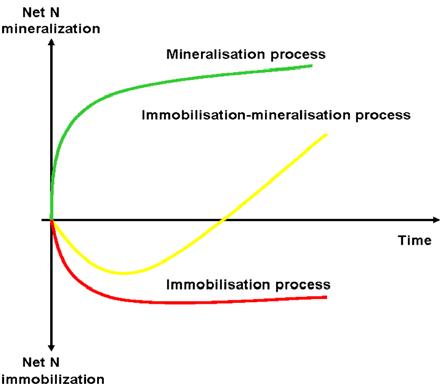
Systems (SVS) programme will incorporate a crop residue breakdown model. This will assist growers when planning fertiliser applications for the following crop.
The first of these factors is crop type. Generally, vegetable crops have a higher nitrogen concentration than cereals, grasses or legumes. Some brassica crops can even contain in excess of 200 kgN/ha in the crop residue following harvest. It is important to note however, that residue nitrogen concentration is just one of the factors influencing availability of nitrogen in the soil. The total mass of the residue (both above and below ground) also has a significant impact and is dependent on the crop and the harvest index of that crop. Also throw into the mix the even greater impact of leaving behind a whole crop in the field due to market dynamics, be that grade standards or demand at the time of harvest.
Because of this dynamic between nitrogen concentration of crop mass left in the field, crops with a low nitrogen content, such as soybean and wheat, can actually contribute as much nitrogen in their residues – if not more –than some high nitrogen concentration vegetable crops. Cover crops are often grown to improve soil structure, reduce erosion, mop-up excess nitrogen and add to the soil organic matter. They can also provide a good source of nitrogen to the following crop if timed correctly. It is important to consider that the quantity of nitrogen returned to the soil is highly dependent on crop management. For instance, if a cereal crop was to be incorporated at the green stage, it would contain significantly more nitrogen than it would as post-harvest
straw, not to mention the portion of nitrogen embodied in roots which is not usually measured.
It should be noted that the amount of nitrogen present does not always correlate to the amount of nitrogen available to the following crop. In fact, incorporation of crop residues that are low in nitrogen themselves can actually decrease the supply of mineral nitrogen through immobilisation. The soil microbes essentially borrow nitrogen from the soil to get sufficient energy to consume the residues that are low in nitrogen. Once they have consumed the residues they die off and the nitrogen they had been using is released.
One of the variables affecting the mineralisationimmobilisation equilibrium (whether or not nitrogen gets tied up or is available for plant uptake) is the carbon to nitrogen ratio. In general, cereal crops have the highest C:N ratio (i.e., have a low amount of N) and vegetable crops have the lowest (they contain a high amount of N). Low C:N ratios generally result in more mineralisation than those with high C:N ratios. Low lignin (the chemical component that makes plants rigid) and cellulose concentrations, and a low lignin to nitrogen ratio also assist with mineralisation.
Climate conditions also play a role in the rate of residue decomposition, since the rate of organic matter decomposition by microbes increases with higher temperatures (though this decreases when temperatures exceed ~35°C). Higher moisture also increases mineralisation rates, with soil at field capacity having the greatest rate of mineralisation.
 Figure 2. The mineral N levels changes from October 2020 to February 2022 with various crops
Figure 2. The mineral N levels changes from October 2020 to February 2022 with various crops
Placement of residues can contribute to slower rates of decomposition when residues are left on the soil surface, though this is not always true for low C:N ratio crops (e.g., leafy vegetables). Treatment of crop residues, e.g., leaving them on the surface, or cultivating them in, is thus a potential tool for manipulating the timing of when crop residue nitrogen is released.
Crop residue addition to soil can result in three different processes occurring in the soil, these being mineralisation, immobilisation or immobilisation followed by mineralisation (Figure 1). The quality of the residue, primarily its C:N ratio, lignin and cellulose contents will dictate which process will take place.
Cereal straw, with a high C:N ratio of 50–80, can have its residue nitrogen and any additional available soil nitrogen tied up by soil microorganisms as they decompose the large quantity of carbon. Therefore, there can be a net nitrogen immobilisation (temporary tie up) of up to 15 kgN/ha during the early stages of residue decomposition. This may not be obvious in a soil where there is plenty of nitrogen present, but could become evident as yellowing in a crop that is grown under low soil nitrogen conditions. In contrast, grasses and vegetable crops decompose much faster as they contain more nitrogen and are therefore not nitrogen limited. While the C:N ratio is a good guide to the expected rate of decomposition, it will not always guarantee breakdown behaviour. For instance, despite their low C:N ratio legumes decompose slower than other vegetable crops due to their higher lignin content.

Source: Sharp JM, Khaembah EN, Fraser PM, Gee M., 2023. A literature review of arable and vegetable crop residues, with emphasis on nitrogen status and factors affecting residue decomposition and nitrogen release.
The SVS regional monitoring programme has nine sites across the country, from Pukekohe to Canterbury. Of the 40 crops sampled across these nine sites over the past three years, 14 were analysed – based on having a fallow period following harvest of greater than two months duration. Of these 14 crops, six were vegetables, five were grasses and three were cereals. While this is not enough data to draw firm conclusions from, it does help to demonstrate the general information described above. Excluding outliers, the average mineral nitrogen level in the top 30cm at harvest was approximately 38 kgN/ha (range: 5 – 167 kg N/ha). The average maximum mineral nitrogen level within three months of harvest was 65 kgN/ha (range: 14 – 177 kg N/ha). During this period, the change in soil mineral N content for each crop was highly varied, ranging from -54 kg N/ha to +150 kg N/ha. It should be acknowledged however, that other factors working concurrently would also have influenced N gain (e.g., soil organic matter mineralisation) or loss (e.g., leaching) in the system.
Cereal crops (three) had the lowest average increase in nitrogen following harvest at just 1 kgN/ha. An outlier maize crop, not included in the analysis of the three cereal crops, had by far the largest decrease in soil mineral nitrogen following harvest at 54 kg N/ha, a combination of immobilisation and loss. This crop did have unusually high mineral nitrogen levels at harvest.
Vegetable crops had an average nitrogen increase of 22 kgN/ha, ranging between a decrease of 38 kgN/ha (cabbage) to a gain of 121 kgN/ha (cauliflower). Grasses had the largest average nitrogen increase, at 51 kgN/ha, ranging from a decrease of 5 kgN/ha to a gain of 150 kgN/ha.
While the monitoring of soil mineral nitrogen levels observes the changes, this is influenced by a range of factors, of which crop residue breakdown is just one. Nitrogen flowing through the system is concurrently being driven by other important variables such as leaching and soil organic matter mineralisation rates. High rainfall during the fallow period may have resulted in the loss of any mineralised nitrogen from residue and may show up in our monitoring as no change in soil mineral levels. While high temperature and moisture may have incorporated additional nitrogen from the mineralisation of soil organic matter already present in the soil.
Considering these factors and the small sample size, the results of this short analysis are demonstrative rather than statistically significant, and highlight the high level of variation in crop residue breakdown and resulting nitrogen availability. This small sample does however, validate the literature discussed previously, with grass and vegetables providing a greater nitrogen supply to the soil than cereal crops on average.
The SVS programme will continue to work towards better understanding the factors affecting residue breakdown and mineralisation to ensure growers can have better confidence in making management decisions based on previous crop residues.

One of the significant benefits to come from the SVS nitrogen budgeting tool is that the different nitrogen pools are accounted for, even if conservatively to start with, and modelled from planting to harvest. Then measured soil nitrogen levels can be used to ground truth the nitrogen budget as the season progresses. A nitrogen budget is just like a financial budget. They are both essential planning tools, but having created a financial budget you then need to check your bank account, and that is the same for a nitrogen budget, it needs to be checked by testing the soil mineral nitrogen level.
So, is a three-month fallow period more risky than two months? Unfortunately, the answer is “it depends.” Therein lies the fun of growing vegetables.
Across industries and applications, we design specialised solutions.
Bringing together leading brands in processing, inspection and packaging equipment for the vegetable industries. Our solutions set the standard for yield, efficiency, and safety across a wide range of industries. Whatever your product needs, we can meet it with precision and passion.




Complete Vegetable solutions designed for your business
ALL THE LATEST NEWS FROM YOUR PRODUCT GROUPS
 52 CONSUMER TOMATO PRICE FLUCTUATIONS
52 CONSUMER TOMATO PRICE FLUCTUATIONS

This month we’re starting our search for applicants who would like to join the Vegetables New Zealand board as a Future Director. In this issue of NZGrower, as you read about all the latest developments in our industry, are you thinking about the direction that New Zealand’s vegetables sector is heading? This is your chance to help shape the future by gaining experience in governance, leadership and strategy.
We started our Future Leader internship in 2022. We offer this 12-month internship as a great way for leaders to gain experience at board level and prepare them to steer the future of horticulture in this country. It’s a great development opportunity for a future leader with a genuine interest in governance. This position will suit an applicant who has active involvement in a horticultural
enterprise giving an understanding of the issues and challenges that horticulture and growers face.
As you know, Vegetables New Zealand is levy funded by commercial growers. The board has seven directors: all are grower-selected appointments. We cover a wide range of topics: biosecurity, food safety, the environment, people capability, grower support and representing growers to government.

The year-long appointment starts in August 2023. In making the selection, VNZI diversity policy will be taken into account. We’ll announce the successful candidate at the Vegetables New Zealand Annual General Meeting on 2 August, followed by an induction during August or September. Their first VNZI board meeting will be in late September 2023 (meeting date subject to VNZI board schedule). The VNZI board meets five times a year in Wellington and around New Zealand’s growing areas, and holds meetings in between via Zoom. The Future Director will have the opportunity to be mentored by an industry leader and receive governance training.
IF YOU ARE INTERESTED IN THIS ROLE, PLEASE SEND YOUR CV AND COVER LETTER TO: LYNDA.BANKS@HORTNZ.CO.NZ

Supplied
Commercial vegetable growers can now sign up to a powerful new tech tool designed to support decision making and better management of common New Zealand plant diseases, including downy mildew.
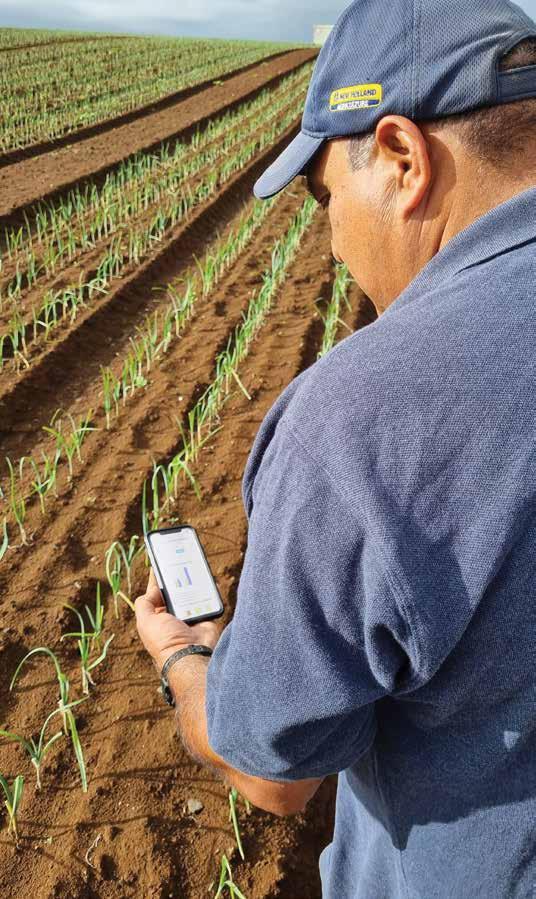
The Vegetables NZ Weather & Disease Portal, launched in April, provides weather forecasts and easy-to-understand information about disease risk by combining data from a nationwide network of weather stations with disease models from leading New Zealand researchers. It is available to all commercial vegetable growers via the ‘Weather & Disease’ button on the Vegetables NZ website, www.freshvegetables.co.nz.
“We are thrilled to be making this tool available to our growers, weather pays a crucial role in the production of vegetables and having readily available, accurate information helps our growers make informed decisions around crop activities” said Vegetables NZ research, development & extension Manager Daniel Sutton.
“At present it offers weather insights and a disease model for downy mildew risk which will be of particular interest to shallot and garlic crops, but there’s huge potential for more pest and disease models to be added over time, based on what will provide the most value for vegetable growers.”
The portal was developed in collaboration with Kiwi agritech experts HortPlus – a company with 25 years of experience developing with some of New Zealand’s leading minds.
HortPlus Director Mike Barley says the company is proud to be working with a forward-thinking organisation like Vegetables NZ.
“We’re excited at the potential the weather and disease portal offers and can’t wait to see the impact it has across New Zealand’s vegetable industry.”
“While the platform will be launching initially with weather and forecasting tools as the focus, there is potential to add more pest and disease models to further support the kinds of data-driven decisions that can reduce crop losses, increase productivity and drive positive sustainability outcomes through more targeted agrichemical use.”
Mike Barley says Vegetables NZ services a diverse industry representing growers of more than 55 different crop types
so the future potential for future crop-specific additions to the portal is “immense”.
The Metwatch Platform that powers the Vegetables NZ Weather & Disease Portal is also used by a range of other sectors, from kiwifruit and summerfruit, to apples and arable crops, with different tools and crop-specific pest and disease models for each.
Mike says there are opportunities to enable integration between the Vegetables NZ portal and the weather and disease portals used by other industries such as Onions NZ and the Foundation for Arable Research, recognising that many vegetable growers also grow other crops.
In addition to growers, the portals are also used by researchers and agronomists for more advanced modelling and data insight.
The portal is available free of charge via the ’Weather &
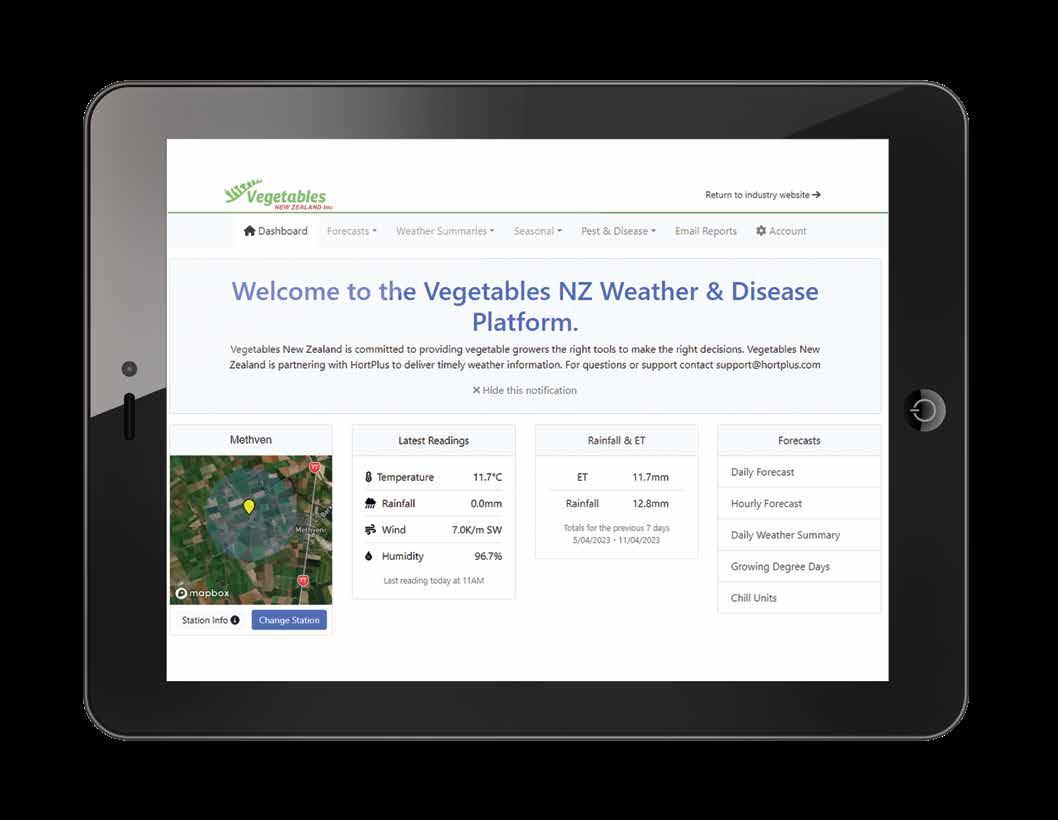
Otago University PhD student PAULINE CERVANTES is the recipient of an Onions NZ and Vegetables NZ joint scholarship working to study the endophytic fungi in New Zealand vegetable crops. Here she shares initial findings from her research.

One of the goals for my PhD is to highlight the value of our native plants as resource pools for beneficial fungi. Many fungi have plant growth promoting benefits, for as insect pathogenic species they are capable of acting as natural biopesticides. As climate change progresses and consumer behaviour alongside it, there is a need to explore how some of these naturally occurring beneficial microbes can be used as biofertilisers and in integrated pest and disease management.
Here are some findings from using endophytic fungi isolated from native tussock grasses Chionochloa rubra and C. rigida, some which have demonstrated positive benefits in stimulating healthy onion growth and development, leading to better crop productivity in a glasshouse experiment.

Onion trials
After initial trials with Metarhizium novozealandicum, positive effects on plant growth were observed. More fungal endophytes were then used in a larger trial in the Otago University Botany Department glasshouse with Pukekohe long keeper onions, which demonstrated 1) increases in root and leaf weight and 2) increases in germination rate and bulb weight.
Pukekohe long keeper onions growing inside the glasshouse
Treatments with entomopathogenic endophytes resulted in an increase in average root dry weight by 8 percent and 9 percent for Metarhizium novozealandicum SS99 and Beauveria pseudobassiana, respectively. Onions treated with Metarhizium sp. FS resulted in the greatest increase in average root dry weight, by 36 percent. Plants treated with Arthrinium sp. on average had a 37 percent decrease in average root dry weight. Similarly, Trichoderma harzianum treated onions resulted in a
0.3 percent decrease in average root dry weight.
The majority of the core endophytes exhibited a decrease in average leaf dry weight, relative to the control. Inoculation with Metarhizium novozealandicum SS99 resulted in the largest decrease in leaf dry weight, by 30 percent. Only Metarhizium sp. FS resulted in a small increase in average leaf dry weight, by 1 percent and overall had a positive effect on both the above and below ground parts of the plant.
Effect of core endophytes isolated from Chionochloa on Pukekohe long keeper onion root dry weight (g)



The effect of the core endophytes on bulb weight varied depending on the species of endophyte (Figure 2).
Metarhizium novozealandicum SS99 had a negative effect on bulb weight resulting in a 10 percent decrease in average bulb weight, relative to the control. Beauveria pseudobassiana had a neutral effect on bulb size, with
a comparable average bulb weight to the control.
Metarhizium sp. and Trichoderma harzianum resulted in a 2 percent and 3 percent increase in average bulb weight, respectively. Although Arthrinium treated onions had a negative effect on the roots and leaves, it had the most pronounced effect on average bulb weight, resulting in a 20 percent increase.


Metarhizium sp.
Top, Control
N= 33, 83% germination success
Bottom
N= 35, 88% germination success
Beauveria
Top, Control
N= 33, 83% germination success
Bottom
N= 40, 100% germination success
Arthrinium
Top, Control
N= 33, 83% germination success
Bottom
N= 31, 78% germination
Metarhizium novozealandicum
Top, Control
N= 33, 83% germination success
Bottom
N= 29, 73% germination success
Trichoderma





Top, Control
N= 33, 83% germination success
Bottom
N= 40, 100% germination success

The same Arthrinium sp. used in the onion trials was also used to treat tomato seedlings. The tomato plants grown in the glasshouse treated with Arthrinium sp. (N= 30) produced more tomatoes compared to the control (N= 30), with the average weight per fruiting plant being 44 percent larger in Arthrinium sp. treated plants (Figure 3). This demonstrates the potential plant growth promoting benefits from the endophyte Arthrinium.
Species of fungi from the genus Trichoderma are well known for their plant growth promoting benefits and
ability to suppress disease, however, our knowledge on many other species of beneficial fungi, including some used in this study are limited. Results from this study suggest there is value in exploring our native plants as a resource pool for beneficial microbes.
Arthrinium is a dominant endophyte in the native tussock grass and although little is known about the direct benefit to its host plant, these results suggest that they are able to improve crop productivity in onions as well as tomatoes.
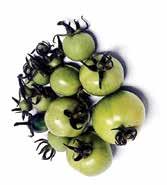






Haven
 Tomato ‘MoneyMaker’ growing in the glasshouse
Tomato ‘MoneyMaker’ growing in the glasshouse
Commercial is focused on design, quality manufacturing, and full safety compliance on commercially rated bunks & beds, in steel or solid timber; proven over many years supply to Seasonal Worker [RSE], Backpacker, Holiday Park, Boarding school & University accommodation facilities. Buy directly from Haven Commercial’s manufacturing supply chain, with the ability to respond quickly to specific requirements of RSE accommodation providers.Effect of Arthrinium of average tomato weight per fruiting plant
This month the team at TomatoesNZ highlights the continued high retail price for tomatoes and how you can help prevent incorrect labelling of imported Australian tomatoes. Tomato growers can register for upcoming events and are encouraged to consider becoming board members. The team also shares news about a new entity for TomatoesNZ and Onions NZ that aims to ensure better use of levies.
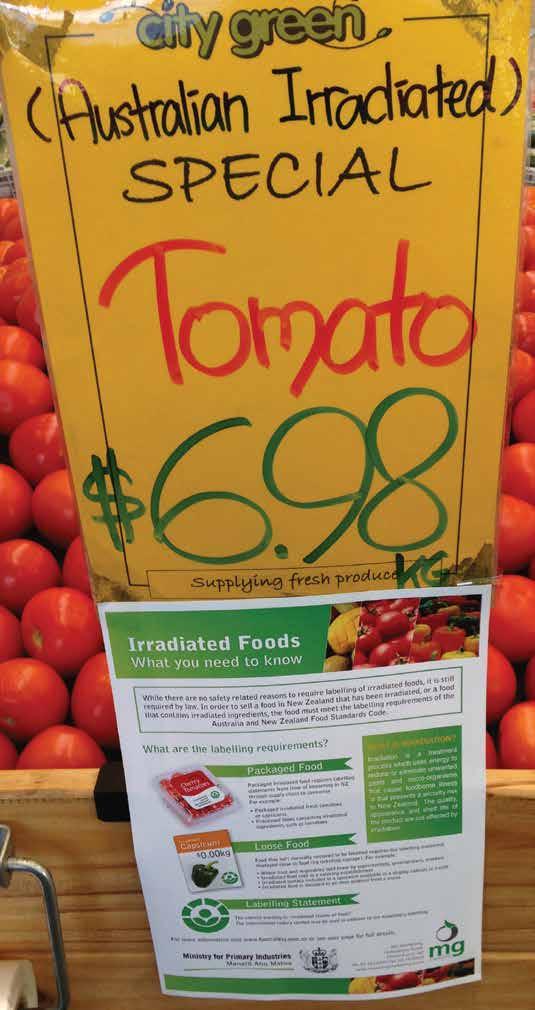
At the time of going to print, testing for PSTVd (potato spindle tuber viroid), which was detected in the Tasman region late in 2022, is returning negative results. Long may this continue! The Ministry for Primary Industries (MPI) has reached out to growers across the country to make sure that this viroid wasn’t going undetected in glasshouses, and again results have all been negative to date. Ongoing testing will continue but all going well, we hope that this response can be brought to a close.
In preparation for such a time, industry has worked to update a code of practice for PSTVd that was in circulation after a previous outbreak. This can be found here: https://www.tomatoesnz.co.nz/about/useful-docs/
TomatoesNZ supports all fresh tomato growers to follow this code as standard practice hygiene, in the hope of limiting future outbreaks.
Don’t forget that if you spot anything unusual about your plants or tomatoes in terms of colouration, wilting etc, you are legally required to report it to MPI by phone 0800 80 99 66 or via the website www.mpi.govt.nz/ biosecurity/how-to-find-report-and-prevent-pests-anddiseases/report-a-pest-or-disease/
 Dinah Cohen : TomatoesNZ Inc business manager
Imported Australian tomatoes are legally required to be labelled as irradiated (file photo from several years ago)
Dinah Cohen : TomatoesNZ Inc business manager
Imported Australian tomatoes are legally required to be labelled as irradiated (file photo from several years ago)
The TomatoesNZ Annual General Meeting (AGM) will take place on Wednesday 2 August at 4.30pm at Te Pae Christchurch Convention Centre. More information, including relevant papers, will be sent out to members, but in the meantime, please consider applying to become a board member. This is the best way to influence how your levy money is spent. TomatoesNZ operates with six elected board members and four observers or co-opted directors, and an independent chair. There are approximately four meetings a year in addition to the AGM and conference. Nominations for board members will open on 24 May, with nomination forms available on the website from this date and via email.
The AGM will be part of the Vegetable product groups speaking sessions, including presentations aimed directly at the covered crop sector. This is part of the ‘Conference Week’, and the day before the Horticulture Conference Week commences on Thursday 3 August. The board and employees of TomatoesNZ really hope to see as many member growers there as possible. Registration for the Vegetable session speaker day and conference has now opened, with early bird rates until 26 May. More information including registration can be found here: https://conferences.co.nz/ hort2023/register/
As you will have seen in the media, the Consumer Price Index (CPI) for fresh tomatoes has remained high throughout the summer. While we know that the prices paid to the grower are a lot less than those paid by the consumer, you might still be interested to see the figures over the last three years for comparison (see above).
With the high prices of tomatoes in supermarkets over the summer, it wasn’t a surprise to see a small number of Australian imported loose round tomatoes in a few retailers in February. It was noted that the supermarkets and online sales of these were not correctly labelled as being irradiated, as they are legally required to be, so a reminder was sent. Overall, the kilo weight of imported Australian fresh tomatoes was down in 2022 (161.5kg compared to 348.5kg in 2021) but if retail prices remain high over winter, this trend is likely to change. If you see Australian tomatoes in your local retailer that are not displaying irradiation signage, it would be helpful if you could take a photo and send it to me Dinah.cohen@hortnz.co.nz
There have been some changes at TomatoesNZ in Wellington with Rebecca Fisher finishing her temporary commitment as the general manager. Rebecca took over from Helen Barnes, who left in February 2022. Rebecca has worked really hard to set up an efficient operation at TNZ moving forward. The board would like to thank Rebecca for her time in the general manager role. Karen Orr, who was on a secondment to MPI in 2022, has moved on to work with the EECA (Energy Efficiency & Conservation Authority) and will continue to help represent covered crop growers in her new role there.
TomatoesNZ and Onions NZ have collaborated to form a new entity ‘Horticulture Executive Services Limited’ (HESL) which sees James Kuperus moving into the chief executive role and Kazi Talaska and myself Dinah Cohen retaining our roles with ONZ and TNZ respectively. There are many common areas among all product groups, and this new entity aims to share knowledge as well as resources to continue the drive towards efficiency that Rebecca started. From a grower’s perspective, it is hoped that this means better use of levies, while retaining the strong focus on the individual projects that are important to each product group.
 Glenys Christian
Glenys Christian
By adopting integrated pest management (IPM) practices New Zealand growers are not on their own, Australian entomologist, Dr Paul Horne, told Pukekohe potato growers at a Potatoes New Zealand research update breakfast meeting in late March.

He said he could give examples in his home country of hundreds of growers who had adopted IPM practices. Not only had they done that but had taken it further, reducing sprays for potato moth from ten to seven per season.
“That’s not far-fetched – it’s basic biology,” he said. “If you’re prepared to put in the effort, you can do the same, I’m absolutely certain.”
One grower of 20 years standing through adopting IPM is now using less chemicals over his whole growing operation than he had previously used on just one crop. “It works,” Paul said.
Based in Victoria, most of the work of his company, IPM Technologies, is in reducing insecticide use by showing
growers and their advisers the impact of chemicals on beneficial species. He and colleague, Jessica Page, who have worked on IPM strategies and training for over 25 years across a range of crops in Australia, are now developing an IPM strategy for tomato potato psyllid (TPP) both there and in this country.
For many crops there are only three control agents; pesticides, management practices and biological control. “There’s nothing else,” Paul said. “That’s what you’ve got to look at.”

It is a key part of good storage or shipping practice to apply Annand


Propham® Potato Dust to prevent sprouting and to keep potatoes fresh, preserve natural flavour, flesh quality and texture.
Easily applied during loading of potatoes
Just one treatment is normally sufficient to keep tubers in condition for 8 months at 6–8oC

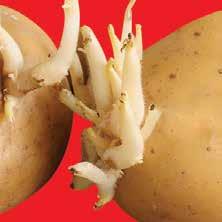
Annand Propham® Potato Dust is packaged in 25kg bags for commercial use
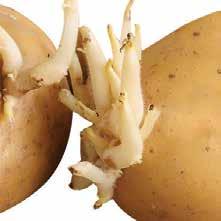 Pukekohe potato growers at a breakfast meeting to discuss IPM
Pukekohe potato growers at a breakfast meeting to discuss IPM
An IPM system is never static and will change over time. Growers can try to add on as many options as they can to build into their strategy.

“People ring us when there’s a crisis, when pesticides don’t work,” he said.
Brassica crops are going through this scenario in Australia at present after some pesticides were withdrawn and export restrictions were enacted because of growers spraying the wrong chemical.
Pests are similar in New Zealand with the main problems for potatoes being potato tuber moth (PTM), which can cause significant damage where there is no cool storage on or offshore. Beneficial insects can be used such as parasitic wasps and damsel bugs, which are more important across the Tasman. As well damsel bugs and brown lacewing can be used on TPP as well as aphids, thrips and caterpillars.
There are predatory thrips as well as pest thrips, and a parasitic wasp which stings PTM was introduced over 50 years ago. There are now three of these wasps established in Australia, compared with just one in New Zealand. Paul Horne said a big advantage is that PTM caterpillars can be dissected in the field to find the wasp maggots, instead of needing to breed the wasp in a laboratory “and then telling the grower they should have sprayed three weeks ago.”
Another parasitic wasp of Lepidoptera which isn’t present in this country, Copidosoma, is polyembryonic, meaning it can divide and produce 50 wasps. Cultural controls are equally or possibly more important, he said. “I’m not telling you anything you don’t already know.”
Soil management, rolling, variety selection and irrigation all help to maintain soil structure. As the crop dies down moths lay their eggs on the soil and caterpillars can go down the small soil cracks to find potato tubers. “So your soil cover needs to be good, because it doesn’t take much soil to stop them going down,” he explained.
Controlling weeds such as fat hen could get rid of thrips, and self-sown potatoes could be a big problem.
“Use chemicals only as a supporting tool,” he told growers. Growers should consider the impact that spraying could have on beneficials, choosing them on the basis of the insects they want to look after. “You might choose a soft chemical, rather than blasting everything away. And if you choose the wrong product you can make things worse.” In one case he was involved in, an Australian grower who used few pesticides but sprayed fungicides every few weeks mistakenly applied Axe, a broad spectrum insecticide instead of the fungicide, Miravis® Ace.
“Early on he smelt it but by the time he called application off half the paddock had been sprayed.”
When Paul later monitored the paddock every leaf he turned over had aphids present, an exponential increase. The incorrect spray application had killed off the ladybirds and lacewings which would usually take out the aphid population.
“Fortunately there was no virus present, but if there had been it would have been rampant.”
Many pesticides are safe with biologicals, which means a strategy has now been built up with many control options.
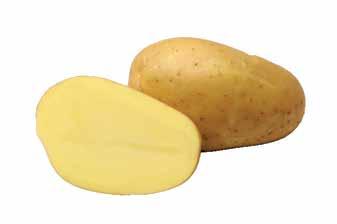
Main season French fry variety, light yellow flesh, excellent for long term storage
NORTH ISLAND
Suresh Wallabh
M +64 21 153 3089
E suresh@eurogrow.co.nz
Tony Hendrikse
M +64 29 96 88 237
E tony@eurogrow.co.nz
SOUTH ISLAND
Elliott Crowley
M +64 27 380 3080
E elliott@eurogrow.co.nz
the original suppliers of Agria
 Australian entomologist Dr Paul Horne speaking in Pukekohe
Australian entomologist Dr Paul Horne speaking in Pukekohe
To support this growth, they relocated in July 2022 to larger premises, offering increased warehouse space and Ellepot production facilities. To ensure this growth is well managed and to confidently meet the needs of customers, Advanced Hort completed the implementation of a full inventory and business process system, and have found these are already showing significant improvements in process and overall business efficiency.
The relocation to new premises meant they could establish a production centre supplying Ellepot Paper Pots. The Ellepot machine is up and running and can be loaded with a grower’s preferred growing medium, ready to seed. Further customisation is available with specifically developed Ellepot papers, including organic options adapted for vegetables, forestry, flowers, landscape, hydroponic and fruit and nuts. There are many options available to customise the Ellepots to suit specific requirements, from paper degradation time, media mixes, pot diameters (from 20mm to 80mm), fertiliser blends or tray type.
Ellepots are degradable, so better for the environment. They offer smarter propagation and faster establishment for healthier root development, resulting in more uniform plants, improved crop timing and a reduction in plant shrinkage. Ellepots are highly reliable and flexible and offer better plug integrity for automated transplanting and handling. They significantly reduce logistics and labour costs through easier and faster transportation, eliminating transplant shock and increasing plant quality, health and root structure. Over the last seven months of operation, the Ellepot machine at Advanced Hort has supported the industry by providing growers in all sectors with paper pots filled and freighted across the North and South Islands.
Advanced Hort are actively seeking growers nationwide for field trials of Ellepot Paper Pots, as they want to document and visually record the amazing results they have seen so far.
At Advanced Hort new staff have joined the team. Nathan, the managing director, continues to liaise direct with growers, but he is now supported by Penny as office manager and Nick as operations coordinator. Advanced Hort are also increasing their technical support team with recruitment underway for another field technician.
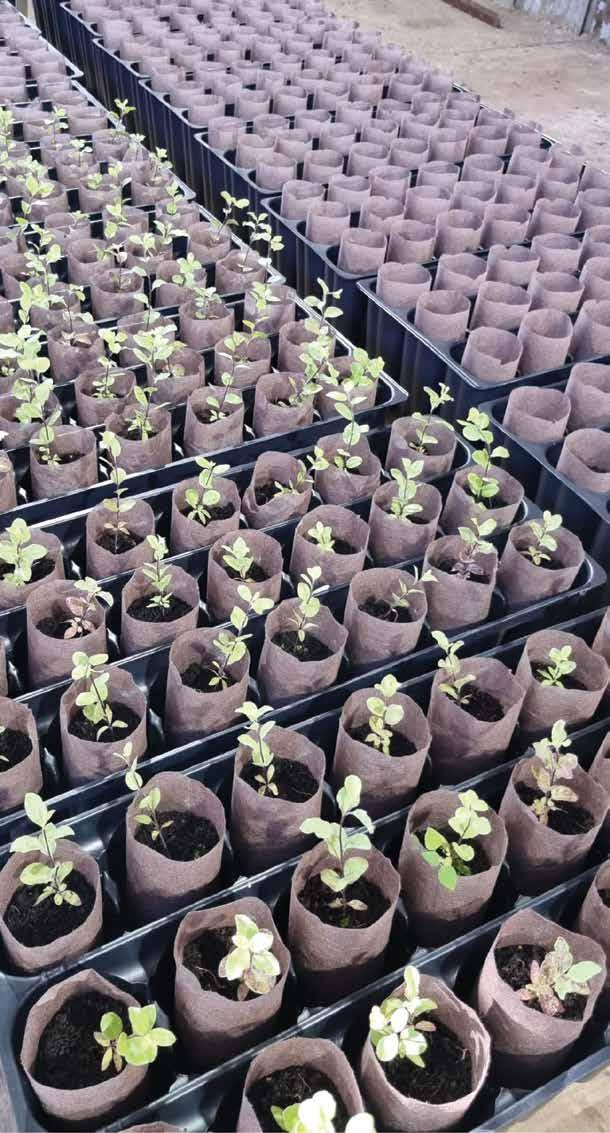
All-encompassing is how Kevin Manning, Fruitfed Supplies Technical Manager, describes the process of looking for new products to trial by the company’s Research and Development (R&D) team.
Fruitfed Supplies has been conducting R&D trials on products seeking registration in New Zealand for decades, offering an independent assessment of the efficacy of a product in local conditions.
As regulatory requirements become tighter, fewer products are available for use within a crop protection programme. For growers to be able to continue to produce export quality fruit and vegetables, R&D trials of potential new solutions are vitally important.
“Our longevity and involvement in the many layers within the horticultural industry allows us to gain a good understanding of what issues are currently being faced by growers. Our role is to take this information and find the most appropriate products to trial,” says Kevin.
To comprehend what tools are being developed around the world, Kevin travels overseas to visit businesses, universities and research organisations. “By taking this knowledge and marrying it with our discussions with local suppliers and the wider industry here, a complete picture soon forms of what products are suitable for trialling.”
There is mounting pressure on companies around the types of products they can bring to the market, as Kevin explains. “The regulatory environment is becoming more challenging with increasingly strict guidelines around what products can be developed.”
This has seen a move towards biopesticides and biostimulants, for instance. Kevin confirms these made up
30 percent of the products trialled last year in vegetable crops. The challenge is fitting them into crop protection programmes and maintaining good outcomes. It is by trialling a product that these results are found.

Trials follow a methodology beginning with site selection. While the company, Kevin says, has research blocks, most trials are completed in cooperation with growers on their blocks. “We’re fortunate growers understand the benefits of these trials, for themselves and for the wider industry.”
In a pest or disease trial, an area is left untreated, while in another area a standard crop protection programme is run. In a third area, the new product is applied at differing rates. This allows the team to assess which rate is the most effective. Once these initial trials are run, in subsequent seasons, the product is trialled within a commercial programme to assess its compatibility.
At the trial’s conclusion, data is presented as evidence to support the claims made on the product label. This information forms a part of the application for registration with the Environmental Protection Authority (EPA) and with the Ministry for Primary Industries under the Agricultural Compounds & Veterinary Medicines (ACVM) Act. This data answers important questions about a product’s safety and efficacy as Kevin explains. “The trials are comprehensive; we want growers to understand a product’s capabilities and fit within a programme.”

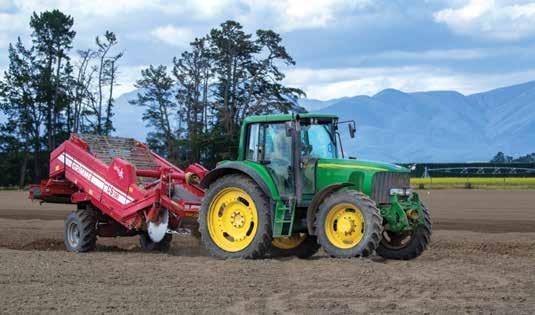
Wearparts NZ are agri-machinery parts specialists with a focus on quality. They aim to reduce your wear costs per hectare, reduce machinery downtime and therefore improve your bottom line.
Sales manager Oliver Wycherley is proud of how far the business has come. “Wearparts started in a single office based in a Manawatu foundry. “Working with this foundry we focused on creating high quality cultivation wearing parts and supplying these direct to users.”
Over the last ten years the business has greatly increased its product range, but they have remained passionate about their central business objective –helping their customers reduce machinery wear costs and downtime. They do this by improving the design of wearing parts to be more efficient and longer wearing where possible, and ensuring quality parts are sourced from leading European, American and New Zealand manufacturers. Selling direct to market is a more efficient system that cuts out the middleman to provide the best pricing to customers.
Now based in a custom-built warehouse in Feilding, Wearparts stock over 2000 parts here in New Zealand. The Wearparts product lines include power harrow and rotary hoe tines, mulcher flails, cultivation parts, a large range of Broekema harvester parts and an innovative emergency web joiner. While all parts are non-genuine they are tested and proven to be of highest quality to suit leading machinery brands such as Kuhn, Celli, Maschio, Kverneland and Berti.
In 2017 Wearparts became an official Broekema dealer. With this partnership, Wearparts work with world leading specialists with over 60 years’ experience developing and manufacturing harvester belts and webbing. As a Broekema dealer Wearparts is also able to stock a large range of rollers, sprockets and joiners to suit Grimme, Top Air, Lockwood and various other root crop harvesters.
emergency web joiner,” Oliver explains. “This is a simple and durable way to fix a broken web in the field using only a hammer or pliers – no welding required. Getting your machinery back up and running in just a few minutes.”
Wearparts is proud to be a 100 percent New Zealand owned and operated business. With their head office and central warehouse located in the heart of the Manawatu they are able provide efficient freight services nationwide with overnight delivery options. Staff all have a background in horticulture or agriculture and are uniquely placed to understand the challenges faced by growers.
If you would like to discuss your parts needs or request a catalogue, call the Wearparts team on 0800 00 31 32 or email info@wearparts.co.nz

The availability of pre-prepared produce in supermarkets is helping many of us eat more vegetables. In response to demand for retail ready produce, vegetable producers are adding commercial grade cutting equipment to their production lines, and by doing so are adding extra profits to their annual yields.
After harvest, size reduction technology is used to shred, cut and dice produce into ready-to-go options that consumers can buy later from supermarkets. This Innovative processing equipment is a great way to make products standout from other market offerings in this space, and cash in on consumer trends.
The low carb, gluten-free vegetable noodle is replacing traditional grain-based pasta in midweek meals and retail ready vegetable slices, strips and cubes are adding variety to meals such as pastas, salads, soups and garnishes.
Settings on size reduction equipment can produce pastalike cuts in a range of appealing thicknesses. With the use of this type of equipment, parsnips, turnips, swedes, celeriac and other root vegetables are easily cut into long strips, that look like noodles when cooked.
Alternate cuts for carrots and zucchinis can produce wavy or straight long noodle strips, riced cuts or even bow-tie crinkles. New products continue to be developed in this space and time poor consumers happily pay the premium for on-trend options such as cauliflower rice and riced broccolini, which can be used instead of rice.
Pre-cut and portioned vegetables are an expanding market, and high-performance food dicers offer the very latest cutting advances. While basic cutting methods can expose vegetables to release more moisture (resulting in shortened lifespan and best before dates), commercial grade equipment will deliver clean, precise cuts that achieve highest possible shelf life. Minimal processing also means that pre-packaged vegetable strips, slices or cubes will maintain their nutritional benefits.

Recent developments in size reduction technology have led to the development of equipment that slices, dices,

strips, granulates and shreds in an extremely quick and precise manner. The range of produce that can be processed is long but not limited to potatoes, carrots, onions, cabbage, lettuce, celery, tomatoes, apples, aloe vera, melons, squash, cucumbers, peaches, pears, strawberries and much more. The cut sizing is wide and varied.
Equipment can be purchased with a built-in discharge conveyor which conveys cut product onto another conveyor or further equipment in the production line. Large infeed capability can even accept product up to 356mm in any dimension, which is suitable for producers of large whole cabbages, lettuces or cauliflower heads.
Urschel are the global leaders in food reduction technology. They deliver quality-manufactured, size reduction solutions for the fresh produce industry and help food operators produce a wide array of cuts in the shortest amount of time. Urschel is sold exclusively in New Zealand and Australia by Heat and Control.
IF IT’S FRESH PRODUCE IN NEW ZEALAND, WE HAVE IT COVERED.
Reaching all levy-paying growers of vegetables in New Zealand.



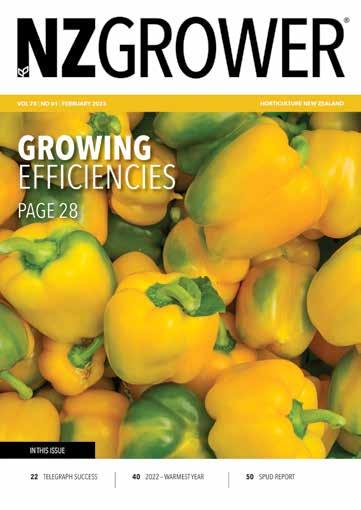
PRINT New Zealand resident NZ$165 (GST inclusive) Australia & the Pacific NZ$280 (airmail delivery) Rest of the World NZ$305 or US equivalent (airmail)
For information about how to subscribe please visit hortnz.co.nz/news-events-and-media/magazines

